#April 1787
Text
Goethe am 30.04.1787 in Sizilien - Bald meine Photos von diesen Seiten hier?
#CMReisen #CMFreizeit #Goethe #Sizilien #April #ItalienischeReise #JohannWolfgangVonGoethe #Agrigento #Girgenti
Goethe war am 30.04.1787 in Sizilien.
Bald meine Photos von diesen Seiten von der »Italienischen Reise« von Johann Wolfgang von Goethe hier?
Und wart ihr nie in Agrigento, die auf der Zeit von Goethe den Name Girgenti hatte?
Goethe war in Girgenti.
View On WordPress
#1787#30. April#Agrigento#April#April 1787#Girgenti#Italien#Italienische Reise#Johann Wolfgang von Goethe#Südsizilien#Sizilien
0 notes
Text
Vagabond

Vagabond — wandering from place to place without any settled home
Poly Lost Boys x GN Reader
Synopsis: Forgiveness is a fickle thing. When four souls find each other, the world finds its equilibrium once more; until the absence of another tips the scale forever. What happens when a familiar face shows itself back at the boardwalk after twenty years of absence?
Warnings: slight angst, lots of historical information in the beginning
Word Count: 3k
By issuing the Declaration of Independence, adopted by the Continental Congress on July 4th, 1776, the 13 American colonies severed their political connections to Great Britain.
You had been ten during the conflicts between America and Great Britain, young and impressionable. Your family came with Puritans, who set sail to America back in 1630. Unlike the Pilgrims, who had left ten years earlier, the Puritans did not break with the Church of England but sought to reform it. All that happened before you were born; your ancestors had settled down and spread their roots into American soil.
You recalled little of the American Revolution; after all, you were very young back then, but you remember December 15th, 1791, vividly. Your mother couldn't stop crying that day, and your father had pulled out the oldest whiskey they had that day. America was finally severed from the tyrannical rule of George III.
You came to understand the significance of those dates more as you aged, growing into a strong individual as you helped your family on their farm. You never intended to marry; it wasn't something you had ever desired or looked forward to. The same year you had gotten married was the day you lost your immortality; both events are related but not necessarily connected. You were introduced to the vampiric community in New Orleans, a city that used the day to sleep off the mistakes you made throughout the rambunctious night.
You had lived through the formation of the Constitution of the United States of America in 1787 when the founding fathers sought to implement more structure into the now independent country.
The infamous whiskey rebellion. American drunks apparently were not too keen about Alexander Hamilton implementing a liquor tax to try and raise money for the national debt; asserting the federal government's power back in 1794.
Only nine years later, the Louisiana Purchase happened in 1803. The small land purchase for only $27 million created room for the states of Louisiana, Missouri, Arkansas, Iowa, North Dakota, South Dakota, Nebraska, and Oklahoma, along with most of Kansas, Colorado, Wyoming, Montana, and Minnesota.
Throughout the 1810s and 1830s, you had moved on from New Orleans and left for New York, seeking human connections and reconnecting with the younger generations. During that time, the Battle of New Orleans in 1815 and the Monroe Doctrine in 1823 seemed to fly past you.
Then, signed on February 2nd, 1848, the Treaty of Guadalupe Hidalgo finally brought closure to the Mexican-American war. At this time, you were no stranger to political conflicts anymore, and the stench of blood and sweat staining battlefields was, unfortunately, no stranger.
Life moved on regardless, no matter the horrid realities life provided. For a short while, life had finally come to a stand-still, guns tucked away as the world in America resumed its development. Until April 12th, 1861, Confederate troops fired on Fort Sumter in South Carolina's Charleston Harbor at 4:30 A.M., A day that changed America forever, the beginning of the American Civil War.
The Emancipation Proclamation, The First Conscription Act, The Battle of Chancellorsville, The Vicksburg Campaign, The Gettysburg Campaign, The Battle of Chickamauga, The Battle of Chattanooga, The Siege of Knoxville. The list continued, and the coppery smell of wasted humanity tainted the air, the wind carrying the cries of victims throughout the nation.
The war ended in the Spring of 1865. Robert E. Lee surrendered the last major Confederate army to Ulysses S. Grant at Appomattox Courthouse on April 9th, 1865.
The number of soldiers who died throughout those four years eventually got estimated to be around 620,000.
Only 47 years later, on July 28th, 1914, the Austrian Archduke Franz Ferdinand was assassinated, beginning the cruel trench warfare of World War I. In early April 1917, America aided the effort to join a war to end all wars. You had entered the war effort, like everyone capable at the time; from soldiers to nurses, everyone gave aid.
On November 11th, 1918, the war ended. Although the Allies won, you found no reason to celebrate. Not when mothers sold their homes since there wasn't a reason to have a multiple-bedroom house anymore, when graveyards overflowed with the dead, when people mourned their losses, when mothers' only answer to their missing sons was a notice declaring their child missing in action.
The stock market crashed in 1929, kicking off the Great Depression that would last for more than a decade.
On September 1st, 1939, Germany invaded Poland. Kicking off World War II and beginning one of the most brutal warfare's, Blitzkrieg. On May 8th, 1945, Germany surrendered. After the atomic bomb was dropped on Hiroshima and Nagasaki, Japan surrendered on September 2nd, 1945, and the Second World War came to an end.
The war ended, and the surviving soldiers returned with missing limbs and broken spirits. You were a firm believer that humans were not meant to witness so much death; it tainted them; it dulled them. Although you were a vampire, a creature supposedly made for horror, you could not forget what you had witnessed in only the span of 21 years.
You were 201 years old now, relatively young in the grand scheme of time, but you had lived through a few of the greatest horrors the world had ever seen.
189 years of traversing the lands, you watched grow in a desperate search to find one of your own. Since you were turned and left New Orleans, you had not met a single vampire. You watched with sorrowful wisdom in your eyes as the world passed through you, virginity in people's expressions you wish you had. A gaze untainted by warfare, civil unrest, and brutality.
Although you have met the occasional human to brighten your own world, it did not cure you. Your search was desolate—fruitless.
Your feet had carried you to Santa Carla, the year now being 1963, and just as the five stages of grief had settled on acceptance. You bumped into a group of four rambunctious bikers that would change your life forever. That had been the first time you had met, and you had continued to live together, going on to live through the Civil Rights movement and grieving the assassination of Martin Luther King, Jr.
But on August 12th, 1967, you left Santa Carla. Your absence is only justified by a delicately written letter standing in your place. You had grown to love the boys, but you had lived differently compared to them.
Marko and Paul were younger vampires than you, having been turned while The Great Depression was bulldozing America. Dwanye had been older, abandoning his immortality in the 18th century along with David. All of them possessed the innate ability to move on from the past, a talent you, unfortunately, did not possess.
No matter how hard you tried, you could not find peace or excitement in the future. The uncertainty corrupted you, tormented you and your experiences, so you left. Not with the intent to abandon but to sort out whatever you had to sort out. Away from the prying eyes of those you loved, those who you did not want—couldn't disappoint.
Santa Carla, the town you had never been able to forget. It was 1987 now; twenty years had passed since you had seen the four vampires. You had missed them—a melancholic weight having nestled its way into your heart ever since you left. You regretted the way you had left through a simple letter. A cowardly move; you were wise enough to understand that. But at the time, you couldn't bring yourself to say it to them. How could you? Look someone in the eyes, someone like you—your own pack that never did anything but love you—and tell them you were leaving?
You didn't have the heart, and if you were a little more honest, you didn't have it now, either. But you missed them more than your hurt pride by walking what felt like a walk of shame as you wandered around the busy boardwalk. One thing you never could get used to was the constant shift in fashion, it felt like the ins became the outs overnight, and you never were able to keep up with it.
Bright colors were the most fashionable now, with teased hair and loud makeup. You enjoyed it, your knowing eyes watching over the crowd. The smell of hairspray permeated the air, wafting towards you as you passed people. Bulky and oversized clothes were spotted throughout the crowds, some men and women wearing specific member-only jackets. Ah, it seems the surfer nazis still haven't given up on Santa Carla yet.
The amusement park was new; back in 1867, the boardwalk had small shops littered around—like a market. Originally it mostly sold food and groceries, fish caught fresh from the sea, and farmers selling their produce.
How has the pier changed so significantly? If it wasn't for the bold, attention-seeking sign that said Santa Carla Boardwalk; you would've thought you were at the wrong address. But stepping on those old wooden floorboards of the pier that occasionally creaked or sunk under your feet was an all too familiar feeling. The smell of salt, rotting seaweed that had washed onto the shore, and the fresh street food made you feel all too at home.
It felt like you had never really left.
Your appearance had changed quite a bit since you left Santa Carla, so you didn't expect either the boys or Max to really recognize you. But although you were willing to stay under the radar for the boys, Max was another story. He was a head vampire, a coven leader, and therefore needed to be notified of your presence.
Entering Max's video store made you feel nostalgic, the same old grimy bell still hanging atop the doorframe signaling your arrival; you had been the one to put that there to originally annoy Max. You were surprised he kept it. The wooden floorboards and furniture gave off a distinct, homey smell. You had been there when the store was built, and the shiny coating across the floors now had grown mat, occasional wood panels brighter in color than before.
"I never thought I'd meet the day I saw you walk through those doors again."
Turning around, you met the stern gaze of Max. His outfit made you smile, a desperate attempt at blending in with the crowd. Max was always a stickler for blending in; if he had no intention of turning you; you had no business knowing who; or rather what, he was.
"It's good to see you."
"I'm flattered, but I doubt that I am the sole reason you returned." Max always carried that knowing tone, as if he's watched out every move you'd make before you made them. It reminded you that Max had a coven before the boys and you, one he rarely conversed about. Perhaps Max really had seen this turn out before, but analyzing that surprised expression, you could only assume who had left never did come back.
"How right you are," You sighed, shoulders dropping as you hopped onto the cashier counter. It was before opening, meaning you and Max had some time to chat privately.
"Twenty years is a long time," Max hummed, a low and almost chiding tone. "What made you come back?"
"To us, it isn't," You weakly argued back. The cumbersome feeling, or rather an awareness that you were in the wrong, was nearly unbearable. You were smart enough to understand that denial was a fruitless endeavor, and yet you couldn't help but let those desperate attempts escape you.
"For people waiting for you, it's an eternity." Max sighed in a calm but chiding tone. Although Max never did have to scold you the way he did with the boys, from not committing arson to preventing fights. Max instead focused his guidance towards you on a more emotional level, the morality; a bit ironic being taught by a vampire—but he did his best.
You glanced outside, through the glass walls of Max's shop, watching the bustling crowd pass you. Twenty years to a vampire was nothing, but somehow the short span of time felt arduous. Why did you come back?
"I never intended on staying away forever. I knew that when the time was right, I'd return." You explained, stealing a quick glance at Max. The older man had a frown etched onto his face, eyebrows furrowed as his own gaze lingered on the rambunctious humans outside. So unaware of the constant and unrelenting passage of time. It was cruel to be immortal; the passage of time no longer hindered you. But emotions are bendable and are the only aspect of ourselves that remains from who we were. Emotions were mortal.
"Santa Carla has changed, Y/N. It is not what you left behind; they are not the same as they were alongside you." Max recalled, his voice disapproving.
You knew Max was correct; you knew deep in your wrenching and twisting gut. You jumped off the counter, your feet hitting the floor like gravity had shifted around you, sinking your body into the floor. "I know," you knew; perhaps the boys didn't even want to see you; they could curse you out and send your name to hell for all eternity. They deserved to do it too.
But they loved you once, and perhaps you can't help shake the feeling that they might love you again this time too.
Max sighed, walking over to his front door and twisting the closed sign around, and pronouncing the store now open. Each tap of his foot, synced with his steps, was like a thundering echo inside you. It prompted you to get up and to provide closure for the others. You reach the door, opening midway before Max leaves you with some parting advice.
"I hope you find what you came here for, Y/N. But the time might be right for you now, but it might not be for them."
You nodded, not looking back as you walked out of the store. The air was warmer, humid from the ocean breeze mixing into the air, the notorious assassin for any styled and teased hair due.
Laughter was one of your favorite sounds. As cliche as that might sound, it felt rejuvenating to hear. Whether it was a loud cackle mimicking the call of a hyena or a high-pitched wheeze or whistle. There was a beauty in people's expressions, how their noses tended to scrunch up, or how others held their stomachs and nearly doubled over. Laughter was infectious, and you loved observing the dopamine spread to others. Strangers connecting over a similar sense of joy; there was a beauty in it.
The boardwalk was filled with it, people brushing shoulders against shoulders as they walked. Groups cackling and shoving each other as they enjoyed the youngness of the evening. Music booming from different directions, punks blasting the newest rap or metal music, hippies tuning out to a gentle jam, but the loudest seemed to be a distant concert down the boardwalk and closer to the pier. Like a bee sensing some honey, you followed. Dodging the occasional passerby, ducking out of the way from shop owners lugging their merchandise around.
The music got louder, and a small thread of excitement seemed to push you further, faster. Your small stroll transformed into a quickened step, your ears guiding you and your eyes following the crowd. The music was loud; a tight smosh-like pit had formed before the stage where people grind and brushed against each other to the beat of the music.
Looking around, you scanned the faces of teenagers and young adults. There was an eager but dreaded nervousness to your gaze at the thought of seeing a face that looked familiar. But it wasn't your eyes that caught their presence, but rather your sense of smell.
Copper.
Although it was harder to pick up when the wind stills its prancing, the occasional breeze led you further towards the pier. Away from the smosh pit, and where people stood to enjoy the music but not risk getting mulled over by a hormonal teenager.
There they stood, strikingly familiar. Although some of the fashion had changed, most of their originality stayed intact. That tiny red flag tied around Dwayne's waist was something the two of you had stolen from a stingy bar owner back in 1964; Markos jacket still had all too familiar patches sewn into its denim fabric; Paul still wore those bracelets you gave him, and David wore the most prominent reminder of you, his oversized coat.
The wind picked up around you, a cold and mocking breeze flowing through your hair and betraying your presence to the four men you had left behind all those years ago. One by one, heads lifted, smiling ceased, and laughter died. Although you had spent years preparing yourself for this moment, nothing felt so gut-wrenchingly real than standing before them.
How do you look someone in the eyes after you've abandoned them?
How do you move past that moment when the world around you stills and halts. When you lose yourself in the blear of the world when mortality reaches its hand around your heart and squeezes. A vice-like grip, a feeling blooming within your chest so heavy–so unspeakable. When you see those eyes, recognize the sorrow behind them and realize you were the perpetrator. You were the one who put that agony, that sadness there.
The burden of your actions ties itself around your throat like a noose, tight and unyielding, as you realize the cruelty was done by none other than yourself. And there is no way, in any shape or form, you could reverse the damage you've done. Pain is immortal, it might yield to its throbbing, but it never forgets.
A world with your boys back in 1967 exists now only in your memory. The four men, cold as the autumn waters, were your reality now.
"Hello, boys."
#the lost boys 1987#poly lost boys x reader#tlb#the lost boys marko#the lost boys david#the lost boys dwayne#tlb x reader#tlb paul#tlb david#tlb marko#tlb dwayne#dwayne tlb#paul tlb#marko tlb#david tlb#laddie tlb#star tlb#the lost boys star#the lost boys x reader#the lost boys#tlb fanfic#tlb x you#tlb headcanons#tlb imagine#the lost boys paul#the lost boys michael#tlb michael#michael x reader
524 notes
·
View notes
Text
April 11, Xi'an, China, Xi'an City Museum/西安博物院 (Part 1):
Since I didn't take pictures of all the plaques, and some of these artifacts can be near impossible to look up, I will not attempt to name all of them.
The entrance to the Xi'an City Museum, also called 西安市博:

Xi'an city used to be called Chang'an/长安, and was the capital city of 13 different dynasties, including Qin dynasty, Han dynasty, and Tang dynasty. This is a (pretty big) model of Chang'an city in Tang dynasty, including parts of the palace:




Various Buddhist statues from different dynasties:

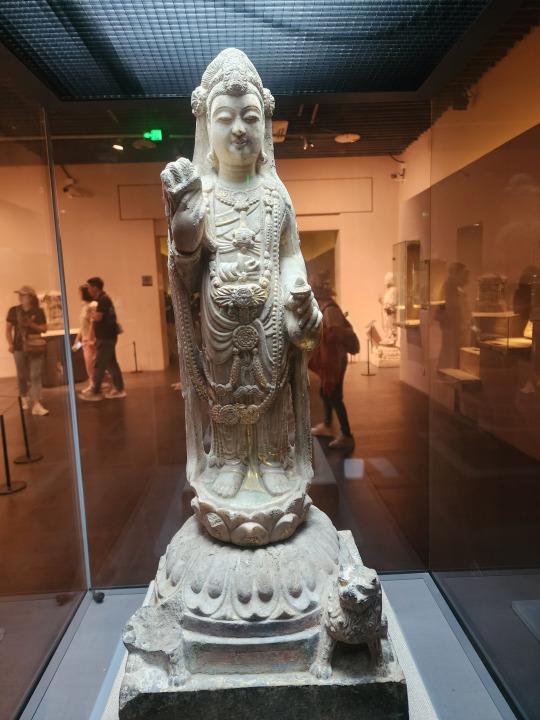

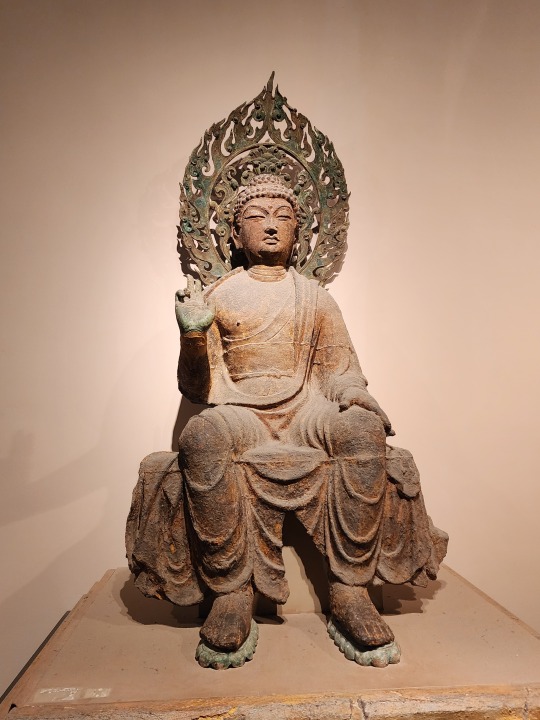
And a statue of Guanyin (Avalokiteśvara) that's in a pose I've never seen before:
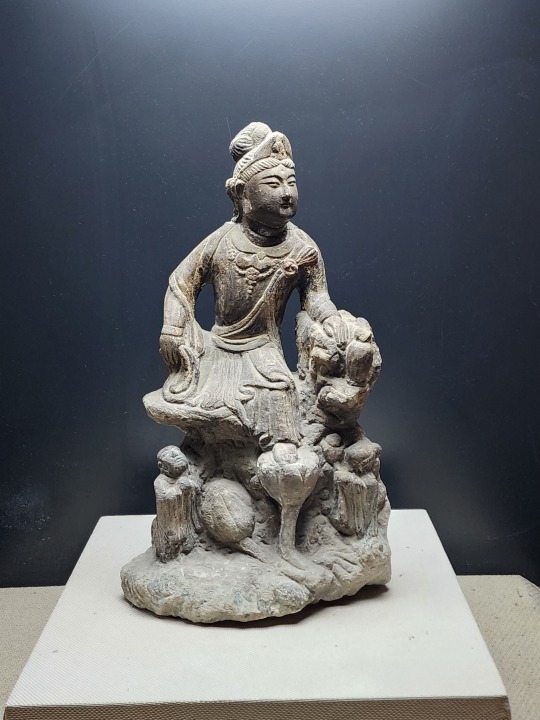
Stone column with a loong dragon and clouds carved upon it:
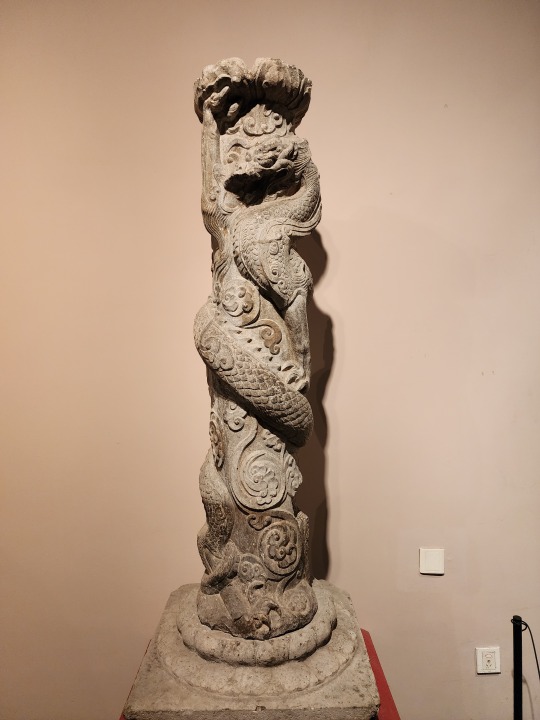
I didn't take a picture of the plaque, but if I remember right this is a bixi/笔洗, or a small bowl containing water where you rinse your brush, and in this case it's fashioned from jade:

A carved jade decor (from a belt?):
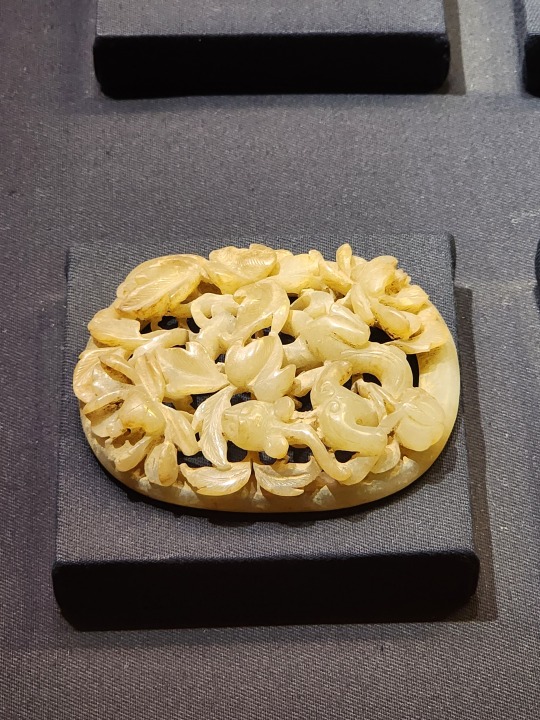
A Qing dynasty jade zhaijie/斋戒 tag. Zhaijie is usually translated as "fasting", but it's more than that, it combines temporary dietary restrictions (definitely no meat or fish/seafood or alcohol, I'm not sure about animal products) and abstinence from a variety of activities, like enjoying feasts, entertainment, and working on official business. Those in mourning may be exempt from zhaijie. This tag was worn by officials when there were major national ceremonies going on, for example the annual ceremonies at Temple of Heaven/Tiantan/天坛 where the emperor prays for rain and a good harvest, as a reminder to observe the zhaijie rules during the ceremony:
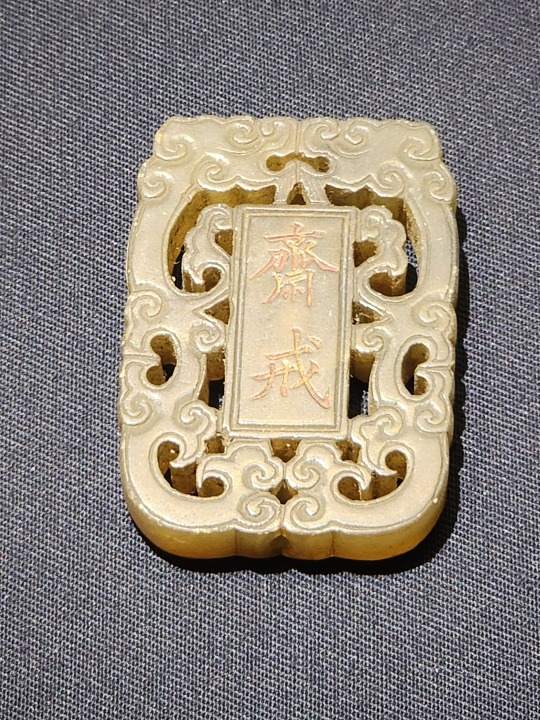
Painting from Republic era (1946). I can literally read everything on the upper left but the name of the painter.........................sigh. Can't find it online either. Anyway I love how the painter created depth here:
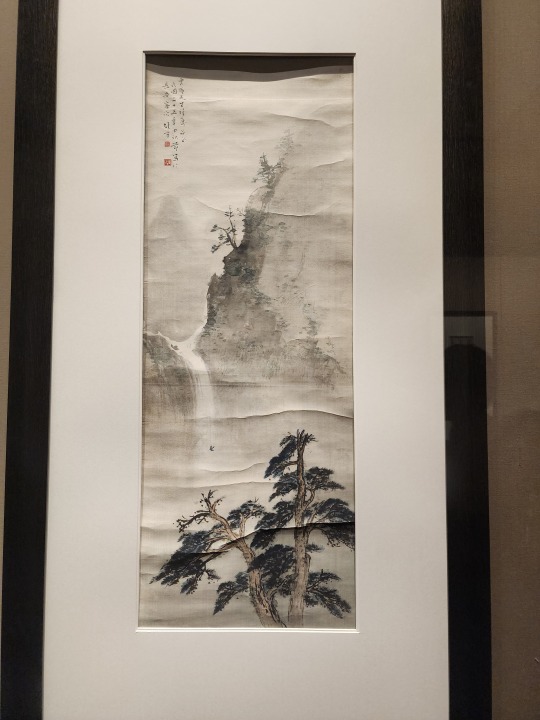
This painting is by Qing era painter Zhang Qia/张洽 in 1787. I love the brushwork:
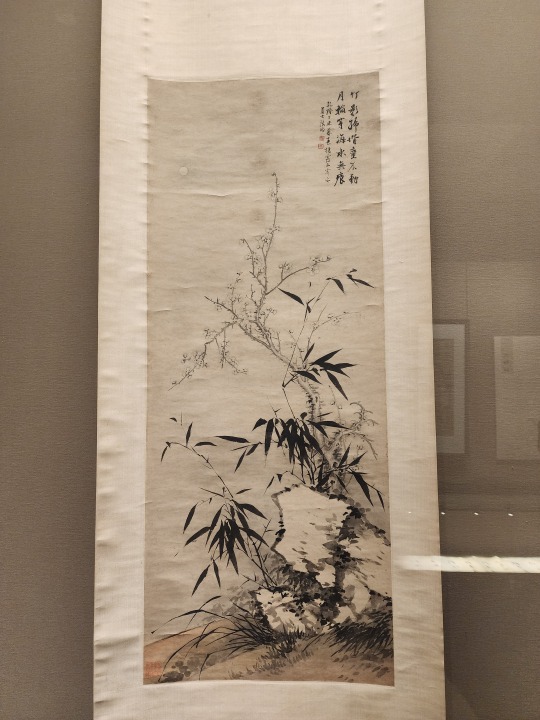
Totally forgot to take a picture of the plaque, but I love this calligraphy:

Bronze ritual wine vessel (called hé/盉) with phoenix head spout, from Warring States period (475 - 221 BC):
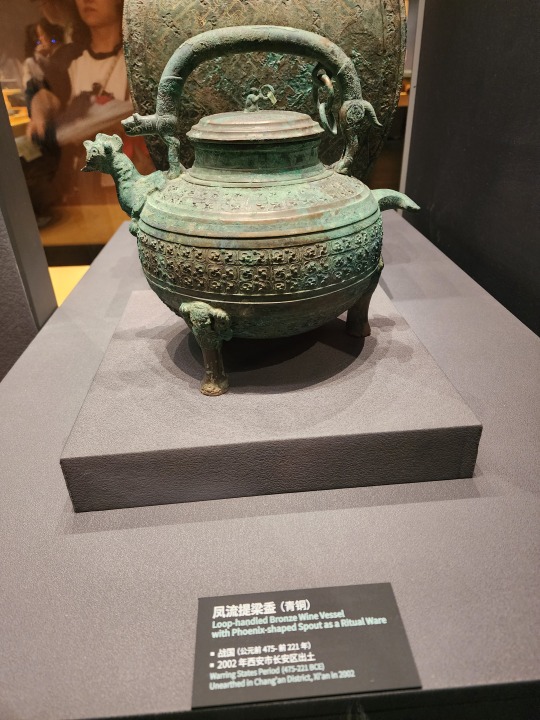
Bronze wine vessel (called jué/爵), if I remember right, this is from Zhou dynasty (1046 - 256 BC):
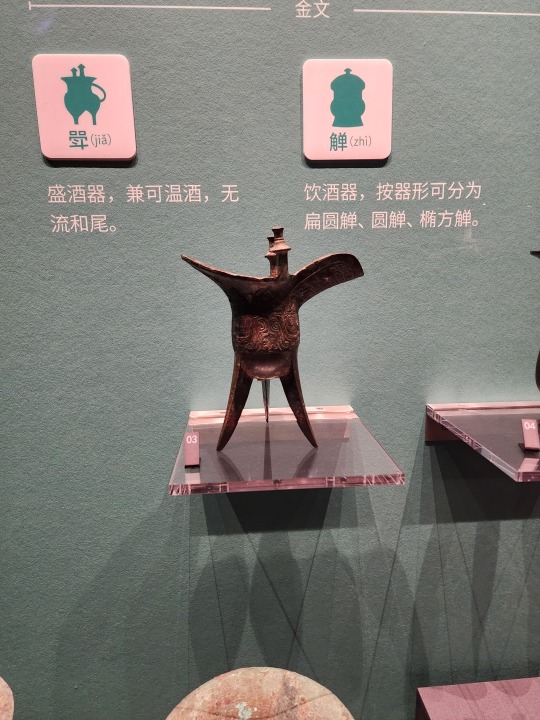
Bronze bells, part of a bianzhong/编钟 set. Although pentatonic scale has been seen as a key characteristic of traditional Chinese music, the bianzhong can play in heptatonic scale. And for the physics lovers out there, this kind of bell is very interesting in that the cross section is almond-shaped, and a single bell can produce two different tones depending on where it is struck. The protrusions on the bell (called mei/枚 or zhongru/钟乳) apparently affect the frequency of the sound produced as well.
The Bianzhong of Marquis Yi of Zeng (曾侯乙编钟) is the oldest playable set that has been found so far, discovered in the tomb of Marquis Yi of Zeng (died 430 BC). A full album was recorded with this ancient bianzhong set in 1989.
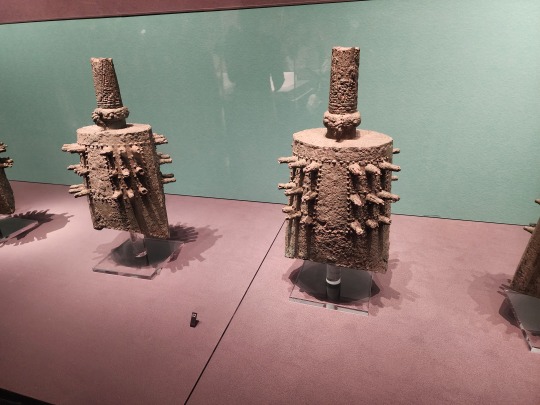
Early currency....yep these are shells. This is the reason why Chinese characters with the shell radical (贝/貝) usually have to do with money or treasure (ex: 财, 寶, 购, 赎, etc etc):
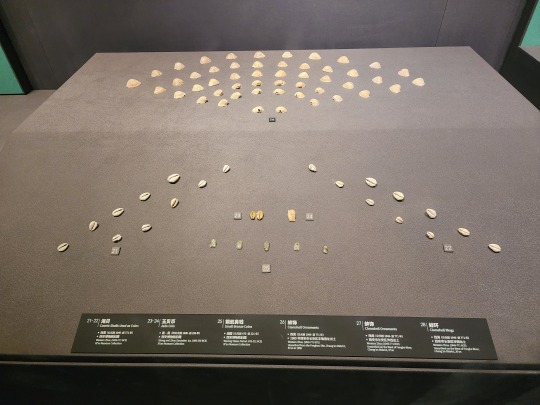
Different coins from different states in the Warring States period:
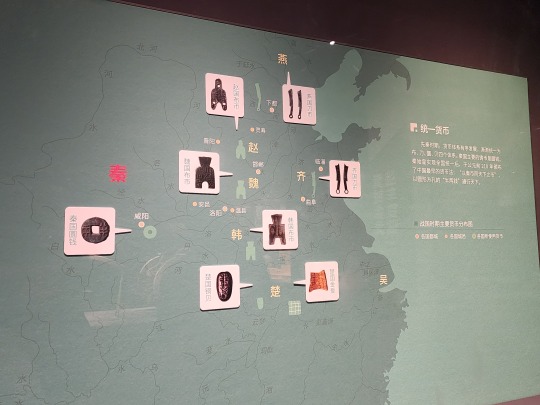

Different coins and molds after Qin dynasty (the weirdly shaped ones are apparently all from Xin dynasty/新莽):

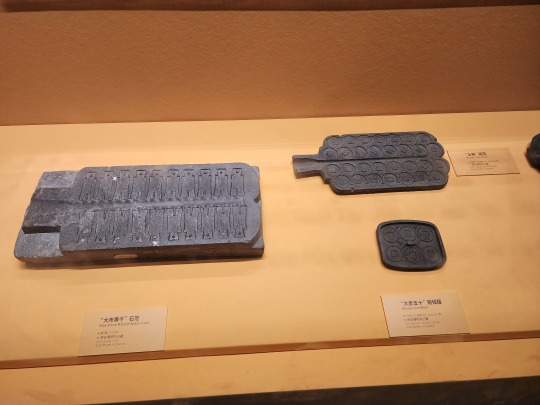
Different seal stamps. I love the one with the turtle on it
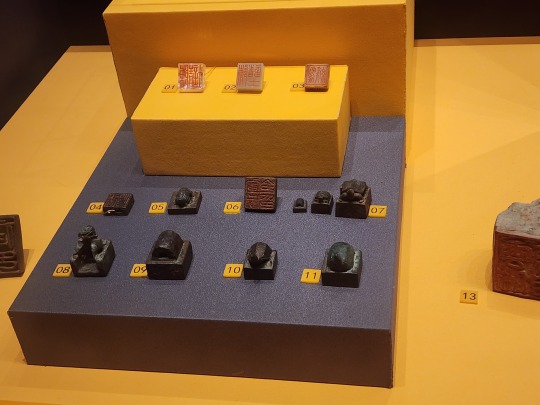
#2024 china#xi'an#xi'an museum#西安博物院#chinese history#chinese art#chinese painting#chinese calligraphy#chang'an#history#art#calligraphy#china#edited since the bell physics article link keeps dying....hopefully I've fixed it for good
98 notes
·
View notes
Text










Milestone Monday
April 15th is National American Sign Language (ASL) Day, observed annually to celebrate the ASL community and its contributions to inclusivity, and to encourage folks to learn the language. Regarded as a natural language, sign language has likely existed for as long as there has been a need to communicate, however, the emergence of ASL is largely credited to Thomas Gallaudet (1787-1851) founder of the American School for the Deaf. Uniting deaf children from the western hemisphere the American School for the Deaf was fertile soil for language contact, developing ASL from French Sign Language, village sign languages, and home sign systems. Today, more than a half-million people throughout the United States use ASL to communicate as their native language.
In recognition of the day, we’re sharing another book from our Historical Curriculum Collection the Basic Pre-School Signed English Dictionary published by Gallaudet College Press in 1973. Signed English features drawn signs with written instructions to represent 975 words most frequently used by and with pre-school children. The editors also include sign markers and the American Manual Alphabet to be used in conjunction with the vocabulary, encouraging a language that is adaptable and offers a more complete English model of communication.
Signed English was edited in part by Harry Bornstein and Karen Saulnier who worked on several signing books for young readers throughout the 70s, 80s, and 90s, and illustrated by Jack Fennell and Ann Silver.
Read other Milestone Monday posts here!
– Jenna, Special Collections Graduate Intern
#milestone monday#national american sign language day#asl#thomas gallaudet#american school for the deaf#basic pre-school signed english dictionary#Gallaudet College Press#Harry Bornstein#Karen Saulnier#Jack Fennell#Ann Silver#historical curriculum collection#children's books
120 notes
·
View notes
Text
The advice I used to impart to young correspondents arriving at the BBC’s bureau in Washington was to remember that the United States had fought a civil war in the mid-19th century and was still arguing over the terms of a fractious peace.
Much like the modern-day phrase “sorry but not sorry,” which is used sarcastically to indicate a lack of remorse, the brief ceremony at Virginia’s Appomattox Court House in April 1865, which brought the armed fighting to an end, was a surrender but not a surrender. White supremacists in the states of the old Confederacy wanted still to reign supreme. Little over a decade later, following the collapse of Reconstruction—an attempt to make good for African Americans the promise of emancipation—enslavement was replaced by segregation. Across the American South, Jim Crow was in the chair.
Now, though, I would amend my advice. I would urge young reporters to reach back even further into history. The roots of modern-day polarization, and even the origins of former President Donald Trump, can be located in the country’s troubled birth. Division has always been the default setting. Victory over the British Redcoats at the Battle of Yorktown paved the way for independence but did not mean U.S. nationhood was a given.
Between the end of the Revolutionary War in 1783 and the start of the Philadelphia Constitutional Convention in 1787, it seemed as if the states might enter into two or three confederations rather than a singular nation as the former British colonies struggled to overcome their antagonisms. “No morn ever dawned more favourable than ours did,” a melancholic George Washington wrote to James Madison in November 1786, “and no day was ever more clouded than the present!”
The Constitution that Washington pushed for, and which was eventually hammered out in Philadelphia, was in many ways an agreement to keep on disagreeing. Compromises that prolonged and protected the institution of slavery—a Faustian bargain that became the price of national unity—created a fault line that was always likely to rupture and explode. It rumbles to this day. Even a Black presidency could not repair the breach.
So many contemporary problems can be traced back to those founding days. U.S. democracy has become so diseased because for most of the country’s history, it has not been that healthy. “We the People,” the rousing words that opened the preamble to the Constitution, was not conceived of as an inclusive statement or catchall for mass democracy. Rather, this ill-defined term referred to what in modern terminology might be called the body politic. Much of the deliberations in Philadelphia focused on how that body politic should be restrained in an intricately designed straitjacket, hence the creation of countermajoritarian mechanisms such as the Electoral College and Senate.
To describe the outcome as an experiment in “democracy” is misleading: The Founding Fathers did not care for the word, which is nowhere to be found either in the Declaration of Independence or the Constitution. When the country’s second president, John Adams, used the term “democratical,” it was intended as a slur. The fear of what some of the founders called an “excess of democracy” explains the thinking behind a quote from Adams that has resurfaced during the Trump years: “Remember, democracy never lasts long. It soon wastes, exhausts, and murders itself. There never was a democracy yet that did not commit suicide.” Adams’s fear was not of unchecked presidential power, the meaning projected onto the quote in relation to Trump. More worrying for him was unchecked people power.
The right to vote was never specifically enshrined in the Constitution, an omission that continues to astound many Americans. To this day, there is no positive affirmation of the right to vote. It is framed negatively—it should not be denied, rather than it should be granted. With good reason, voting is often called the missing right.
Not until the mid-1960s, with the passage of the 1965 Voting Rights Act, did the United States finally achieve what could truly be described as universal suffrage. In the South, Black people could finally cast ballots without being subjected to humiliating “literacy tests,” where they would be asked unanswerable questions such as how to interpret arcane clauses of state constitutions.
No sooner had this landmark legislation become law, however, than efforts to reverse it cranked into gear. So began what has turned out to be a decades-long campaign of de-democratization. It was spearheaded by the Republican Party, which needed to restrict minority voting rights because the demographic trend lines, and the transition toward a minority-majority nation, were thought to favor the Democrats.
These efforts were aided to a disconcerting degree by the conservative-dominated Supreme Court, with rulings that drastically weakened the provisions of the Voting Rights Act. For example, in 2013, Shelby County v. Holder gutted the act’s all-important Section 5, which forced jurisdictions with a history of racial discrimination to “preclear” with the Justice Department any proposed voting changes. In a 5-4 judgment, the conservative justices decided that preclearance was now obsolete because voter registration had shown such dramatic improvements. Yet as the liberal justice Ruth Bader Ginsburg pointed out in an unusually strong dissenting opinion, ending preclearance was akin to “throwing away your umbrella in a rainstorm because you are not getting wet.”
The insurrection on Jan. 6, 2021, then, should not be seen in isolation. It was the culmination of a prolonged assault on democracy that predated the rise of Trump. The attack continued, moreover, after the insurrectionists had been dispersed and the floors of Congress scrubbed clean of excrement. That night, 147 Republicans returned to the chambers to cast votes to challenge or overturn Joe Biden’s presidential victory.
Political violence is a core part of the U.S. story, although much of this history has often been buried and concealed. At the end of the 1960s, a commission appointed by President Lyndon B. Johnson to investigate why the United States was so prone to political assassination concluded that the country suffered from “a kind of historical amnesia or selective recollection that masks unpleasant traumas of the past.” It also noted that “the revolutionary doctrine that our Declaration of Independence proudly proclaims is mistakenly cited as a model for legitimate violence.”
Indeed, the Jan. 6 insurrection showed how political violence is still seen as legitimate and even rendered glorious. Many of the insurrectionists chanted “1776” as they stormed the Capitol. “We’re walking down the same exact path as the Founding Fathers,” claimed Stewart Rhodes, a former Army paratrooper with a Yale University law degree. (Rhodes helped establish the Oath Keepers, a militia group launched on April 19, 2009, the anniversary of when rebels and Redcoats first exchanged fire.) The day before the insurrection, Rep. Marjorie Taylor Greene described it as “our 1776 moment.”
Many far-right extremists are inspired by words from Thomas Jefferson that, unlike the poetry of his Declaration of Independence, never made it into high school textbooks or onto the teleprompters of modern-day presidents. “I hold it that a little rebellion now and then is a good thing, and as necessary in the political world as storms in the physical,” Jefferson wrote in 1787, a quote that has now become a far-right meme. “The tree of liberty must be refreshed from time to time with the blood of patriots” is another of Jefferson’s sayings that has been co-opted by modern-day militias.
Often I recall the day of Biden’s inauguration, which took place on a platform that only two weeks earlier had been used as a staging post for the insurrection. It was festooned with red, white, and blue bunting, but it still felt like a crime scene that should have been sequestered with yellow tape. As I made my way to my camera position on the press stand, I noticed that technicians were testing the giant teleprompter in front of the presidential podium. And I recognized the words on the screen: “Four score and seven years ago, our fathers brought forth on this continent a new nation, conceived in liberty, and dedicated to the proposition that all men are created equal. Now we are engaged in a great civil war, testing whether that nation, or any nation so conceived and so dedicated, can long endure.”
The teleprompter had been loaded with the 272 words of Abraham Lincoln’s Gettysburg Address in November 1863. Maybe it was some kind of sick joke. A rogue technician, perhaps, with a dark sense of humor. But these passages from the country’s most celebrated sermon could hardly be described as out of place. The question at the heart of the speech, and which had also been posed at the country’s founding, was being asked anew: Can this nation long endure?
My sense—my ardent hope—is that the conditions do not yet exist for all-out armed conflict, a second civil war, partly because the United States has accumulated so much muscle memory in coping with its perpetual state of division. But nor do the conditions exist for reconciliation and rapprochement. Nowhere near. So the United States occupies a strange betwixt and between: close to abyss, but a step or two back from the edge. Going to hell, as the wit Andy Rooney once observed, without ever getting there.
The U.S. historian Richard Hofstadter, famed for identifying what he called the “paranoid style in American politics,” put it well: “The nation seems to slouch onward into its uncertain future like some huge inarticulate beast, too much attainted by wounds and ailments to be robust, but too strong and resourceful to succumb.” The fact that Hofstadter published those words at the start of the 1970s speaks to how the United States remains stuck in a rut—revisiting the same arguments, going over the same ground. Americans remain tethered to their contested past. The news cycle is the historical cycle in microcosm. As Lincoln put it in his message to Congress in December 1862: “We cannot escape history.”
So even if the United States does not descend into civil war, it is hard to envision it ever reaching a state of civil peace. The forever war will continue: America’s unending conflict with itself.
38 notes
·
View notes
Photo

US Presidential Election of 1789
The US presidential election of 1789 was the first presidential election to take place after the ratification of the United States Constitution. Held on 4 February 1789, it resulted in the unanimous election of George Washington (l. 1732-1799) as the first president of the United States, with John Adams (l. 1735-1826) elected as the first vice president.
This election was very different from modern-day presidential elections in the United States. For one thing, candidates did not campaign for office, as outward displays of political ambition were viewed with suspicion by the public; instead, aspiring politicians discreetly made their interests known while their allies publicly lobbied for them. Additionally, as there were not yet any formal political parties, presidential and vice presidential candidates did not run on a shared ticket. Instead, the candidate who received the most votes from the Electoral College became president, while the runner-up became vice president. Finally, the president was chosen by electors – who were themselves selected by each state through various methods – who were each allowed to cast two votes. Washington, after his unanimous election, travelled to the temporary US capital of New York City, where he was inaugurated on 30 April 1789.
Background
In March 1781, as the American Revolutionary War neared its end, the Articles of Confederation went into effect as the first framework of governance for the fledgling United States. The Articles, which bound the 13 states together in a league of perpetual union, deliberately kept the new central government weak to protect the sovereignty of the individual states. Congress' lack of authority would soon lead to problems, however; the central government's inability to raise its own taxes meant that the national treasury was constantly depleted, while its lackluster response to Shays' Rebellion (1786-87) showed that it was ill-equipped to handle domestic crises. By the mid-1780s, many Americans viewed the Articles of Confederation as ineffectual and demanded they be revised, if not replaced. George Washington certainly spoke for many of his contemporaries when he called the Confederation Congress a "half-starved, limping Government that appears to be always moving upon crutches and tottering at every step" (mountvernon.org).
On 25 May 1787, the Constitutional Convention met at Independence Hall in Philadelphia, Pennsylvania, with Washington presiding. While the initial goal of the convention had been merely to revise the Articles of Confederation, it was soon decided that an entirely new framework of governance was needed, and the delegates got to work debating and drafting what would become the United States Constitution. As suggested in the Virginia Plan (drafted by Virginian delegates James Madison and Edmund Randolph), it was ultimately decided that the new federal government should consist of three distinct branches: executive, legislative, and judiciary, each expected to exert checks and balances on the others. Debate over the exact powers and functions of these branches consumed much of the convention, particularly regarding the executive branch; under the Articles, the US had no executive officer, as the 'president of Congress' had served more of an administrative role.
On 1 June, it was decided that the nation's chief executive would be a single person rather than a group of persons and that this officeholder would be called the ‘president'. Believing that the masses were too easily manipulated, the delegates decided against electing the president directly through a popular vote and instead set up an Electoral College, wherein voters in each state would choose electors who would, in turn, elect the president. After toying with the idea that the president should serve a single, seven-year term, the delegates instead went with the notion that multiple terms could be served. While the idea of the presidential office seemed foreboding to many convention delegates, who still feared the tyranny of kings, most were lulled into compliance by the idea that Washington would become the first president. Time and again, Washington had demonstrated his patriotism during the American Revolution and had voluntarily resigned his position as commander-in-chief of the Continental Army. The idea that he would be the first one to define the office of president did much to ease fears that the office would become an elective monarch.
Washington at the Constitutional Convention, 1787
Junius Brutus Stearns (Public Domain)
Continue reading...
25 notes
·
View notes
Text
Female Sailors and Marines
Five women who served, unfortunately not much is known about them, but I would like to list them with the female sailors.
In 1781, 17-year-old Margaret Thompson joined the navy in Deptford under the name George Thompson. When a theft was committed on board her ship and all the sailors' chests were to be searched, women's clothing was found in George's chest. It was assumed that he had stolen the clothes when he was last ashore and he was sentenced to three dozen lashes. At this point George admitted that she was a woman and that the clothes belonged to her.
When asked by the captain who she was and what had prompted her to take this extraordinary step, she replied that her name was Margaret Thompson, that she had left her uncle, who lived in London, to see her lover, who had left England three years ago and now lived in Bombay.
Hannah Whitney enlisted in navy 1756. In 1761 while in male attire, she was seized by a press-gang and sent with other victims to Plymouth prison. Served for five years as a marine. She revealed that she was a woman after she had been locked in a cell and became claustrophobic.
Tom Bowling enlisted in navy ca. 1787. A report in the Naval Chronicle in 1807 describes a woman who had served over 20 years as a bowswain's mate on a man-of-war.
William Prothero the Captain's log for the 32 gun ship Amazon records that on 20th April 1761 'One of the marines ... was discovered to be a woman. She had done her duty on board nine months.'
Rebecca Anne Johnston (discovered 1807) came from Whitby, was bound by her stepfather as a seven-year apprentice on a collier ship, but deserted after four years and was found living on the streets, dressed as a sailor. The stepfather had also bound her mother (name unknown)to a ship and she had died during the bombardment of Copenhagen.
What is striking about all these women listed here is that we do not know what became of them later and how they got on board in the first place. With these we simply don't know, because their existence was only briefly mentioned in some newspapers or logbooks. Therefore, there are also some historians who dismiss their existence as pure fiction. However, I believe that these women were simply dismissed after their discovery and went their own ways, whether as penniless begging veterans or back into their female roles in a family. Only the really outstanding personalities were further processed and their stories sold, all the others disappeared again after their discovery as i said and their number is much higher than one might think.
147 notes
·
View notes
Text
God Bless You, My Beloved General, think often of Your Absent and Most devoted friend, Who With all the Sentiments of Unbounded Gratitude, profound Veneration, and filial love Has the Honour to Be for Ever, My dear General Your Most affectionate, and I Know Your Most Beloved friend
The Marquis de La Fayette to George Washington, January 13, 1787
To George Washington from Lafayette, 13 January 1787,” Founders Online, National Archives, https://founders.archives.gov/documents/Washington/04-04-02-0442. [Original source: The Papers of George Washington, Confederation Series, vol. 4, 2 April 1786 – 31 January 1787, ed. W. W. Abbot. Charlottesville: University Press of Virginia, 1995, pp. 514–517.] (03/26/2024)
#marquis de lafayette#french history#american history#la fayette#history#letter#george washington#1787#founders online
22 notes
·
View notes
Text




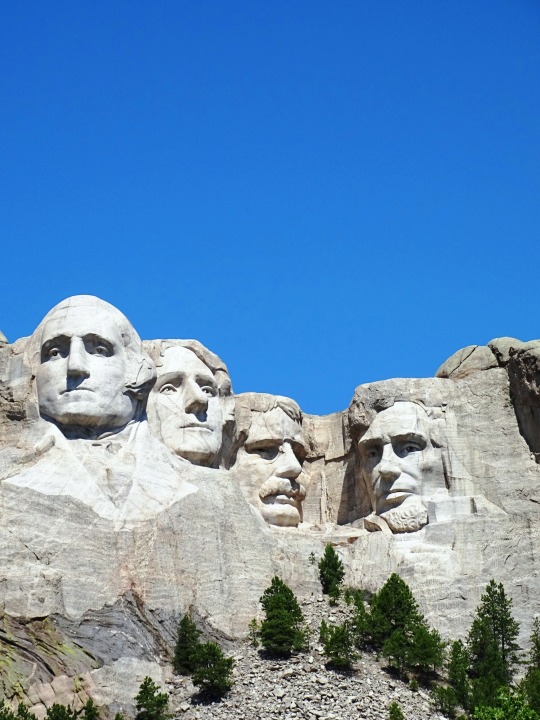







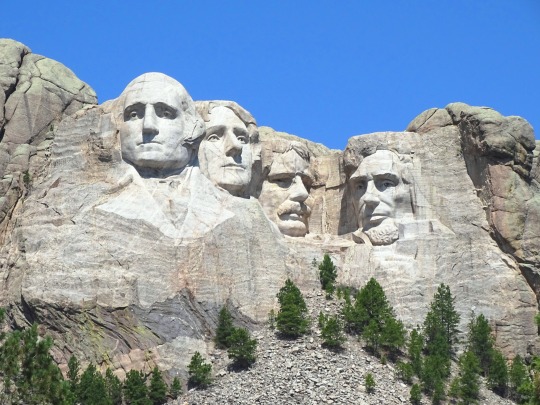
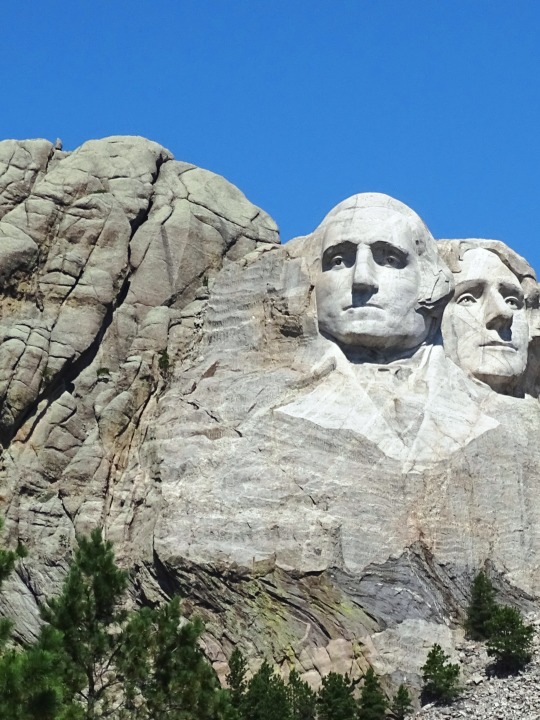
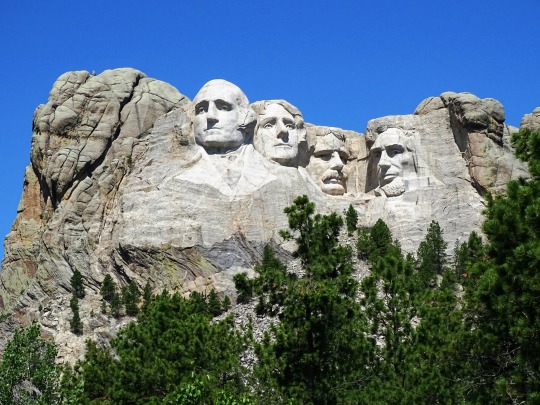
Thomas Jefferson Day
Thomas Jefferson, a founding father of the United States, was born on April 13, 1743. He held many roles and did much during the formative years of the country, including being the main author of the Declaration of Independence and the country’s third president. He wrote his own epitaph, highlighting what he most wanted to be remembered for: “HERE WAS BURIED THOMAS JEFFERSON AUTHOR OF THE DECLARATION OF AMERICAN INDEPENDENCE OF THE STATUTE OF VIRGINIA FOR RELIGIOUS FREEDOM AND FATHER OF THE UNIVERSITY OF VIRGINIA.”
Thomas Jefferson Day is a legal observance, but it is not a public holiday. A joint resolution approved on August 16, 1937, authorized the President of the United States to proclaim April 13 as “Thomas Jefferson’s Birthday” each year. The following year, President Franklin D. Roosevelt issued Presidential Proclamation 2276 to designate the day. Subsequent presidents have made similar proclamations. In Alabama, Thomas Jefferson’s birthday is officially celebrated on Presidents’ Day, along with George Washington’s.
Thomas Jefferson was born at the Shadwell plantation in Albemarle County, Virginia. His mother, Jane Randolph Jefferson, was from a prominent Virginia family, and his father, Peter Jefferson, was a planter and surveyor. After graduating from the College of William and Mary in 1762, he began studying law. As there weren’t official law schools at the time, Jefferson studied under a Virginia attorney. He began his work as a lawyer in 1767.
He married Martha Wayles Skelton on January 1, 1772. They had six children, but only two daughters lived to adulthood. Martha died in 1782 at the age of 33, and Jefferson never remarried. Besides keeping himself busy with politics throughout his life, he had many other interests, including gardening, architecture, music, and reading.
Jefferson was a member of colonial Virginia’s House of Burgesses between 1769 and 1775. He wrote “A Summary View of the Rights of British America” in 1774, which brought him to a wider audience. It said that the British Parliament didn’t have the right to use authority over the colonies. He was then selected to be a delegate to the Second Continental Congress. During this time, a panel of five was chosen to draft the Declaration of Independence. Of the five, which also included John Adams and Benjamin Franklin, Jefferson was chosen to write the draft. It was adopted on July 4, 1776.
In the fall of 1776, Jefferson resigned from the Continental Congress and was elected to the Virginia House of Delegates, which was formerly the House of Burgesses. In the late 1770s, he drafted the Virginia Statute for Religious Freedom. It was a notable forerunner to the First Amendment, and Jefferson thought it was one of his most substantial contributions, being important enough to include in his epitaph. After his time in the Virginia House of Delegates, he was Governor of Virginia from 1779 to 1781.
Following the Revolutionary War, Jefferson was part of Congress, which was known as the Congress of the Confederation at the time. He served from 1783 to 1784, and then became Minister to France in 1785, taking over the position that Benjamin Franklin had held. Because he was overseas, he was not able to attend the Constitutional Convention in 1787.
In the fall of 1789, Thomas Jefferson returned to America and became the first secretary of state. He helped found the Democratic-Republican Party, which opposed Alexander Hamilton’s Federalist Party, a party which wanted a strong central government with strong powers over the economy. Jefferson believed in a federal government with a limited role and believed in strong state and local governments.
He ran for president in 1796 and received the largest amount of votes after John Adams, so he became vice president. He ran against Adams again in 1800, and this time beat him. But his electoral vote count tied that of his running mate, Aaron Burr, and it was up to the House of Representatives to declare Jefferson as president. Because of this, the Twelfth Amendment, which stipulated separate voting for president and vice president, was ratified in 1804.
Jefferson served two terms as president and was in office from 1801 to 1809. During his first term, in 1803, he helped orchestrate the Louisiana Purchase, in which the size of the United States doubled with the purchase of land for $15 million from France. Jefferson sent Meriwether Lewis and William Clark on an expedition, known as the Corps of Discovery, to explore the new land. With this trip, information was gathered about geography, plant and animal life, and American Indian tribes. During his second term, which he secured with over 70% of the popular vote, Jefferson worked to keep the country out of the Napoleonic Wars. He implemented the Embargo of 1807 after merchant ships were getting harassed by France and Britain. It was an unpopular move, though, as it shut down American trade and hurt the economy; it was repealed in 1809. Jefferson did not run for a third term in 1808.
After his presidency, Jefferson retired to his home, Monticello. “Monticello” means “little mountain” in Italian. Indeed the home is located on a small mountain, on the edge of the Shadwell property where Jefferson was born. He had begun clearing the area for a home in 1768. He designed the home and gardens himself, and he continually worked on the house throughout his life. Art and gadgets filled the rooms, and he kept records of everything that went on at the plantation.
During his retirement years, he also helped found the University of Virginia. He helped design both its buildings and its curriculum. He also made sure it wasn’t a religious school and that there wasn’t a religious litmus test in order to attend it.
In 1815, he sold his 6,700 volume personal library to Congress, to replace the books that had been destroyed by the British in the War of 1812, when they burned the Capitol, which housed the Library of Congress at the time. Jefferson’s books became the foundation of what became the Library of Congress’s new library.
Although Jefferson is revered as one of the founding fathers, he is not a man without contradictions and shortcomings. He was a promoter of liberty and wrote “all men are created equal,” but was a slave owner throughout his whole life, during which he owned a total of about 600 slaves. He believed blacks were inferior humans and didn’t think coexistence would be possible if they were free. And although he never remarried after the loss of his beloved wife, Martha, he went on to father more children with one of his slaves, Sally Hemings. Some of the slaves that were in his bloodline were freed after his death, but most of his slaves were sold.
Thomas Jefferson passed away at Monticello at the age of 83, on July 4, 1826, on the 50th anniversary of the adoption of the Declaration of Independence. As if the date of his death wasn’t ironic enough, fellow founding father John Adams died on the same day. Thomas Jefferson died first, but Adams did not know that Jefferson had died, and his last words were “Thomas Jefferson survives.” Jefferson was buried at Monticello. Monticello was sold off following his death to pay debts, but a nonprofit organization acquired it in the twentieth century and it was opened to the public in 1954.
Source
#Thomas Jefferson Day#13 April 1743#anniversary#US history#born#birthday#Mount Rushmore National Memorial#controversial memorial#USA#controversy#Black Hills#South Dakota#Gutzon Borglum#summer 2019#original photography#tourist attraction#landmark#landscape#nature#NationalThomasJeffersonDay#Thomas Jefferson#US President#Teddy Roosevelt#Theodore Roosevelt#Abraham Lincoln#George Washington#North Central Region#Great Plains#travel#vacation
12 notes
·
View notes
Text
"Only a virtuous people are capable of freedom. As nations become corrupt and vicious, they have more need of masters."
Benjamin Franklin , Letter to the Abbés Chalut and Arnaud, April 17, 1787.
102 notes
·
View notes
Text
The napoleonic marshal‘s children
After seeing @josefavomjaaga’s and @northernmariette’s marshal calendar, I wanted to do a similar thing for all the marshal’s children! So I did! I hope you like it. c:
I listed them in more or less chronological order but categorised them in years (especially because we don‘t know all their birthdays).
At the end of this post you are going to find remarks about some of the marshals because not every child is listed! ^^“
To the question about the sources: I mostly googled it and searched their dates in Wikipedia, ahaha. Nevertheless, I also found this website. However, I would be careful with it. We are talking about history and different sources can have different dates.
I am always open for corrections. Just correct me in the comments if you find or know a trustful source which would show that one or some of the dates are incorrect.
At the end of the day it is harmless fun and research. :)
Pre 1790
François Étienne Kellermann (4 August 1770- 2 June 1835)
Marguerite Cécile Kellermann (15 March 1773 - 12 August 1850)
Ernestine Grouchy (1787–1866)
Mélanie Marie Josèphe de Pérignon (1788 - 1858)
Alphonse Grouchy (1789–1864)
Jean-Baptiste Sophie Pierre de Pérignon (1789- 14 January 1807)
Marie Françoise Germaine de Pérignon (1789 - 15 May 1844)
Angélique Catherine Jourdan (1789 or 1791 - 7 March 1879)
1790 - 1791
Marie-Louise Oudinot (1790–1832)
Marie-Anne Masséna (8 July 1790 - 1794)
Charles Oudinot (1791 - 1863)
Aimee-Clementine Grouchy (1791–1826)
Anne-Francoise Moncey (1791–1842)
1792 - 1793
Bon-Louis Moncey (1792–1817)
Victorine Perrin (1792–1822)
Anne-Charlotte Macdonald (1792–1870)
François Henri de Pérignon (23 February 1793 - 19 October 1841)
Jacques Prosper Masséna (25 June 1793 - 13 May 1821)
1794 - 1795
Victoire Thècle Masséna (28 September 1794 - 18 March 1857)
Adele-Elisabeth Macdonald (1794–1822)
Marguerite-Félécité Desprez (1795-1854); adopted by Sérurier
Nicolette Oudinot (1795–1865)
Charles Perrin (1795–15 March 1827)
1796 - 1997
Emilie Oudinot (1796–1805)
Victor Grouchy (1796–1864)
Napoleon-Victor Perrin (24 October 1796 - 2 December 1853)
Jeanne Madeleine Delphine Jourdan (1797-1839)
1799
François Victor Masséna (2 April 1799 - 16 April 1863)
Joseph François Oscar Bernadotte (4 July 1799 – 8 July 1859)
Auguste Oudinot (1799–1835)
Caroline de Pérignon (1799-1819)
Eugene Perrin (1799–1852)
1800
Nina Jourdan (1800-1833)
Caroline Mortier de Trevise (1800–1842)
1801
Achille Charles Louis Napoléon Murat (21 January 1801 - 15 April 1847)
Louis Napoléon Lannes (30 July 1801 – 19 July 1874)
Elise Oudinot (1801–1882)
1802
Marie Letizia Joséphine Annonciade Murat (26 April 1802 - 12 March 1859)
Alfred-Jean Lannes (11 July 1802 – 20 June 1861)
Napoléon Bessière (2 August 1802 - 21 July 1856)
Paul Davout (1802–1803)
Napoléon Soult (1802–1857)
1803
Marie-Agnès Irma de Pérignon (5 April 1803 - 16 December 1849)
Joseph Napoléon Ney (8 May 1803 – 25 July 1857)
Lucien Charles Joseph Napoléon Murat (16 May 1803 - 10 April 1878)
Jean-Ernest Lannes (20 July 1803 – 24 November 1882)
Alexandrine-Aimee Macdonald (1803–1869)
Sophie Malvina Joséphine Mortier de Trévise ( 1803 - ???)
1804
Napoléon Mortier de Trévise (6 August 1804 - 29 December 1869)
Michel Louis Félix Ney (24 August 1804 – 14 July 1854)
Gustave-Olivier Lannes (4 December 1804 – 25 August 1875)
Joséphine Davout (1804–1805)
Hortense Soult (1804–1862)
Octavie de Pérignon (1804-1847)
1805
Louise Julie Caroline Murat (21 March 1805 - 1 December 1889)
Antoinette Joséphine Davout (1805 – 19 August 1821)
Stephanie-Josephine Perrin (1805–1832)
1806
Josephine-Louise Lannes (4 March 1806 – 8 November 1889)
Eugène Michel Ney (12 July 1806 – 25 October 1845)
Edouard Moriter de Trévise (1806–1815)
Léopold de Pérignon (1806-1862)
1807
Adèle Napoleone Davout (June 1807 – 21 January 1885)
Jeanne-Francoise Moncey (1807–1853)
1808: Stephanie Oudinot (1808-1893)
1809: Napoleon Davout (1809–1810)
1810: Napoleon Alexander Berthier (11 September 1810 – 10 February 1887)
1811
Napoleon Louis Davout (6 January 1811 - 13 June 1853)
Louise-Honorine Suchet (1811 – 1885)
Louise Mortier de Trévise (1811–1831)
1812
Edgar Napoléon Henry Ney (12 April 1812 – 4 October 1882)
Caroline-Joséphine Berthier (22 August 1812 – 1905)
Jules Davout (December 1812 - 1813)
1813: Louis-Napoleon Suchet (23 May 1813- 22 July 1867/77)
1814: Eve-Stéphanie Mortier de Trévise (1814–1831)
1815
Marie Anne Berthier (February 1815 - 23 July 1878)
Adelaide Louise Davout (8 July 1815 – 6 October 1892)
Laurent François or Laurent-Camille Saint-Cyr (I found two almost similar names with the same date so) (30 December 1815 – 30 January 1904)
1816: Louise Marie Oudinot (1816 - 1909)
1817
Caroline Oudinot (1817–1896)
Caroline Soult (1817–1817)
1819: Charles-Joseph Oudinot (1819–1858)
1820: Anne-Marie Suchet (1820 - 27 May 1835)
1822: Henri Oudinot ( 3 February 1822 – 29 July 1891)
1824: Louis Marie Macdonald (11 November 1824 - 6 April 1881.)
1830: Noemie Grouchy (1830–1843)
——————
Children without clear birthdays:
Camille Jourdan (died in 1842)
Sophie Jourdan (died in 1820)
Additional remarks:
- Marshal Berthier died 8.5 months before his last daughter‘s birth.
- Marshal Oudinot had 11 children and the age difference between his first and last child is around 32 years.
- The age difference between marshal Grouchy‘s first and last child is around 43 years.
- Marshal Lefebvre had fourteen children (12 sons, 2 daughters) but I couldn‘t find anything kind of reliable about them so they are not listed above. I am aware that two sons of him were listed in the link above. Nevertheless, I was uncertain to name them in my list because I thought that his last living son died in the Russian campaign while the website writes about the possibility of another son dying in 1817.
- Marshal Augerau had no children.
- Marshal Brune had apparently adopted two daughters whose names are unknown.
- Marshal Pérignon: I couldn‘t find anything about his daughters, Justine, Elisabeth and Adèle, except that they died in infancy.
- Marshal Sérurier had no biological children but adopted Marguerite-Félécité Desprez in 1814.
- Marshal Marmont had no children.
- I found out that marshal Saint-Cyr married his first cousin, lol.
- I didn‘t find anything about marshal Poniatowski having children. Apparently, he wasn‘t married either (thank you, @northernmariette for the correction of this fact! c:)
#Marshal‘s children calendar#literally every napoleonic marshal ahaha#napoleonic era#Napoleonic children#I am not putting all the children‘s names into the tags#Thank you no thank you! :)#YES I posted it without double checking every child so don‘t be surprised when I have to correct some stuff 😭#napoleon's marshals#napoleonic
71 notes
·
View notes
Text

Legend: Churchill smoked a staggering amount of cigars.
Reality: By any reasonable standard.
“The number of cigars he smoked is truly extraordinary,” says Fox, whose company sold its first cigars in 1787. Churchill was a client of the store (then called Robert Lewis) at London’s 19 St. James Street. Fox has handwritten ledgers, telegrams and other records that document that the soldier/statesman bought hundreds of thousands of cigars there. During one six-month stretch in 1964—the year before he died—Churchill bought 825 cigars: 250 in April, 275 cigars in June and 100 per month in July, August and September. “It was a pretty consistent pattern of what he was buying,” says Fox. And that wasn’t the only shop supplying him with cigars. “He was doing business with a lot of cigar stores,” says Fox, “but we were one of his largest suppliers.”
20 notes
·
View notes
Text

Footnotes, 251 - 300
[251] A bulky literature, dealing with this formerly much neglected subject, is now growing in Germany. Keller’s works, Ein Apostel der Wiedertäufer and Geschichte der Wiedertäufer, Cornelius’s Geschichte des münsterischen Aufruhrs, and Janssen’s Geschichte des deutschen Volkes may be named as the leading sources. The first attempt at familiarizing English readers with the results of the wide researches made in Germany in this direction has been made in an excellent little work by Richard Heath — “Anabaptism from its Rise at Zwickau to its Fall at Munster, 1521–1536,” London, 1895 (Baptist Manuals, vol. i.) — where the leading features of the movement are well indicated, and full bibliographical information is given. Also K. Kautsky’s Communism in Central Europe in the Time of the Reformation, London, 1897.
[252] Few of our contemporaries realize both the extent of this movement and the means by which it was suppressed. But those who wrote immediately after the great peasant war estimated at from 100,000 to 150,000 men the number of peasants slaughtered after their defeat in Germany. See Zimmermann’s Allgemeine Geschichte des grossen Bauernkrieges. For the measures taken to suppress the movement in the Netherlands see Richard Heath’s Anabaptism.
[253] “Chacun s’en est accommodé selon sa bienséance... on les a partagés... pour dé pouiller les communes, on s’est servi de dettes simulées” (Edict of Louis the Fourteenth, of 1667, quoted by several authors. Eight years before that date the communes had been taken under State management).
[254] “On a great landlord’s estate, even if he has millions of revenue, you are sure to find the land uncultivated” (Arthur Young). “One-fourth part of the soil went out of culture;” “for the last hundred years the land has returned to a savage state;” “the formerly flourishing Sologne is now a big marsh;” and so on (Théron de Montaugé, quoted by Taine in Origines de la France Contemporaine, tome i. p. 441).
[255] A. Babeau, Le Village sous l’Ancien Régime, 3e édition. Paris, 1892.
[256] In Eastern France the law only confirmed what the peasants had already done themselves; in other parts of France it usually remained a dead letter.
[257] After the triumph of the middle-class reaction the communal lands were declared (August 24, 1794) the States domains, and, together with the lands confiscated from the nobility, were put up for sale, and pilfered by the bandes noires of the small bourgeoisie. True that a stop to this pilfering was put next year (law of 2 Prairial, An V), and the preceding law was abrogated; but then the village Communities were simply abolished, and cantonal councils were introduced instead. Only seven years later (9 Prairial, An XII), i.e. in 1801, the village communities were reintroduced, but not until after having been deprived of all their rights, the mayor and syndics being nominated by the Government in the 36,000 communes of France! This system was maintained till after the revolution of 1830, when elected communal councils were reintroduced under the law of 1787. As to the communal lands, they were again seized upon by the State in 1813, plundered as such, and only partly restored to the communes in 1816. See the classical collection of French laws, by Dalloz, Répertoire de Jurisprudence; also the works of Doniol, Dareste, Bonnemère, Babeau, and many others.
[258] This procedure is so absurd that one would not believe it possible if the fifty-two different acts were not enumerated in full by a quite authoritative writer in the Journal des Economistes (1893, April, p. 94), and several similar examples were not given by the same author.
[259] Dr. Ochenkowski, Englands wirthschaftliche Entwickelung im Ausgange des Mittelalters (Jena, 1879), pp. 35 seq., where the whole question is discussed with full knowledge of the texts.
[260] Nasse, Ueber die mittelalterliche Feldgemeinschaft und die Einhegungen des XVI. Jahrhunderts in England (Bonn, 1869), pp. 4, 5; Vinogradov, Villainage in England (Oxford, 1892).
[261] Seebohm, The English Village Community, 3rd edition, 1884, pp. 13–15.
[262] “An examination into the details of an Enclosure Act will make clear the point that the system as above described [communal ownership] is the system which it was the object of the Enclosure Act to remove” (Seebohm, l.c. p. 13). And further on, “They were generally drawn in the same form, commencing with the recital that the open and common fields lie dispersed in small pieces, intermixed with each other and inconveniently situated; that diverse persons own parts of them, and are entitled to rights of common on them... and that it is desired that they may be divided and enclosed, a specific share being let out and allowed to each owner” (p. 14). Porter’s list contained 3867 such Acts, of which the greatest numbers fall upon the decades of 1770–1780 and 1800–1820, as in France.
[263] In Switzerland we see a number of communes, ruined by wars, which have sold part of their lands, and now endeavor to buy them back.
[264] A. Buchenberger, “Agrarwesen und Agrarpolitik,” in A. Wagner’s Handbuch der politischen Oekonomie, 1892, Band i. pp. 280 seq.
[265] G.L. Gomme, “The Village Community, with special reference to its Origin and Forms of Survival in Great Britain” (Contemporary Science Series), London, 1890, pp. 141–143; also his Primitive Folkmoots (London, 1880), pp. 98 seq.
[266] “In almost all parts of the country, in the Midland and Eastern counties particularly, but also in the west — in Wiltshire, for example — in the south, as in Surrey, in the north, as in Yorkshire, — there are extensive open and common fields. Out of 316 parishes of Northamptonshire 89 are in this condition; more than 100 in Oxfordshire; about 50,000 acres in Warwickshire; in Berkshire half the county; more than half of Wiltshire; in Huntingdonshire out of a total area of 240,000 acres 130,000 were commonable meadows, commons, and fields” (Marshall, quoted in Sir Henry Maine’s Village Communities in the East and West, New York edition, 1876, pp. 88, 89).
[267] Ibid. p. 88; also Fifth Lecture. The wide extension of “commons” in Surrey, even now, is well known.
[268] In quite a number of books dealing with English country life which I have consulted I have found charming descriptions of country scenery and the like, but almost nothing about the daily life and customs of the laborers.
[269] In Switzerland the peasants in the open land also fell under the dominion of lords, and large parts of their estates were appropriated by the lords in the sixteenth and seventeenth centuries. (See, for instance, Dr. A. Miaskowski, in Schmoller’s Forschungen, Bd. ii. 1879, Pp. 12 seq.) But the peasant war in Switzerland did not end in such a crushing defeat of the peasants as it did in other countries, and a great deal of the communal rights and lands was retained. The self-government of the communes is, in fact, the very foundation of the Swiss liberties.
[270] Miaskowski, in Schmoller’s Forschungen, Bd. ii. 1879, p. 15.
[271] See on this subject a series of works, summed up in one of the excellent and suggestive chapters (not yet translated into English) which K. Bücher has added to the German translation of Laveleye’s Primitive Ownership. Also Meitzen, “Das Agrar- und Forst-Wesen, die Allmenden und die Landgemeinden der Deutschen Schweiz,” in Jahrbuch für Staatswissenschaft, 1880, iv. (analysis of Miaskowsky’s works); O’Brien, “ in a Swiss village,” in Macmillan’s Magazine, October 1885.
[272] The wedding gifts, which often substantially contribute in this country to the comfort of the young households, are evidently a remainder of the communal habits.
[273] The communes own, 4,554,100 acres of woods out of 24,813,000 in the whole territory, and 6,936,300 acres of natural meadows out of 11,394,000 acres in France. The remaining 2,000,000 acres are fields, orchards, and so on.
[274] In Caucasia they even do better among the Georgians. As the meal costs, and a poor man cannot afford to give it, a sheep is bought by those same neighbors who come to aid in the work.
[275] Alfred Baudrillart, in H. Baudrillart’s Les Populations Rurales de la France, 3rd series (Paris, 1893), p. 479.
[276] The Journal des Économistes (August 1892, May and August 1893) has lately given some of the results of analyzes made at the agricultural laboratories at Ghent and at Paris. The extent of falsification is simply incredible; so also the devices of the “honest traders.” In certain seeds of grass there was 32 percent of gains of sand, colored so as to Receive even an experienced eye; other samples contained from 52 to 22 percent only of pure seed, the remainder being weeds. Seeds of vetch contained 11 percent of a poisonous grass (nielle); a flour for cattle-fattening contained 36 percent of sulfates; and so on ad infinitum.
[277] A. Baudrillart, l.c. p. 309. Originally one grower would undertake to supply water, and several others would agee to make use of it. “What especially characterizes such associations,” A. Baudrillart remarks, “is that no sort of written agreement is concluded. All is arranged in words. There was, however, not one single case of difficulties having arisen between the parties.”
[278] A. Baudrillart, l.c. pp. 300, 341, etc. M. Terssac, president of the St. Gironnais syndicate (Ariège), wrote to my friend in substance as follows: — “For the exhibition of Toulouse our association has grouped the owners of cattle which seemed to us worth exhibiting. The society undertook to pay one-half of the traveling and exhibition expenses; one-fourth was paid by each owner, and the remaining fourth by those exhibitors who had got prizes. The result was that many took part in the exhibition who never would have done it otherwise. Those who got the highest awards (350 francs) have contributed 10 percent of their prizes, while those who have got no prize have only spent 6 to 7 francs each.”
[279] In W¸rttemberg 1,629 communes out of 1,910 have communal property. They owned in 1863 over 1,000,000 acres of land. In Baden 1,256 communes out of 1,582 have communal land; in 1884–1888 they held 121,500 acres of fields in communal culture, and 675,000 acres of forests, i.e. 46 percent of the total area under woods. In Saxony 39 percent of the total area is in communal ownership (Schmoller’s Jahrbuch, 1886, p. 359). In Hohenzollern nearly two-thirds of all meadow land, and in Hohenzollern-Hechingen 41 percent of all landed property, are owned by the village communities (Buchenberger, Agrarwesen, vol. i. p. 300).
[280] See K. Bücher, who, in a special chapter added to Laveleye’s Ureigenthum, has collected all information relative to the village community in Germany.
[281] K. Bücher, ibid. pp. 89, 90.
[282] For this legislation and the numerous obstacles which were put in the way, in the shape of red-tapeism and supervision, see Buchenberger’s Agrarwesen und Agrarpolitik, Bd. ii. pp. 342–363, and p. 506, note.
[283] Buchenberger, l.c. Bd. ii. p. 510. The General Union of Agricultural Cooperation comprises an aggregate of 1,679 societies. In Silesia an aggregate of 32,000 acres of land has been lately drained by 73 associations; 454,800 acres in Prussia by 516 associations; in Bavaria there are 1,715 drainage and irrigation unions.
[284] See Appendix XII.
[285] For the Balkan peninsula see Laveleye’s Propriété Primitive.
[286] The facts concerning the village community, contained in nearly a hundred volumes (out of 450) of these inquests, have been classified and summed up in an excellent Russian work by “V.V.” The Peasant Community (Krestianskaya Obschina), St. Petersburg, 1892, which, apart from its theoretical value, is a rich compendium of data relative to this subject. The above inquests have also given origin to an immense literature, in which the modern village-community question for the first time emerges from the domain of generalities and is put on the solid basis of reliable and sufficiently detailed facts.
[287] The redemption had to be paid by annuities for forty-nine years. As years went, and the greatest part of it was paid, it became easier and easier to redeem the smaller remaining part of it, and, as each allotment could be redeemed individually, advantage was taken of this disposition by traders, who bought land for half its value from the ruined peasants. A law was consequently passed to put a stop to such sales.
[288] Mr. V.V., in his Peasant Community, has grouped together all facts relative to this movement. About the rapid agricultural development of South Russia and the spread of machinery English readers will find information in the Consular Reports (Odessa, Taganrog).
[289] In some instances they proceeded with great caution. In one village they began by putting together all meadow land, but only a small portion of the fields (about five acres per soul) was rendered communal; the remainder continued to be owned individually. Later on, in 1862–1864, the system was extended, but only in 1884 was communal possession introduced in full. — V.V.‘s Peasant Community, pp. 1–14.
[290] On the Mennonite village community see A. Klaus, Our Colonies (Nashi Kolonii), St. Petersburg, 1869.
[291] Such communal cultures are known to exist in 159 villages out of 195 in the Ostrogozhsk district; in 150 out of 187 in Slavyanoserbsk; in 107 village communities in Alexandrovsk, 93 in Nikolayevsk, 35 in Elisabethgrad. In a German colony the communal culture is made for repaying a communal debt. All join in the work, although the debt was contracted by 94 householders out of 155.
[292] Lists of such works which came under the notice of the zemstvo statisticians will be found in V.V.‘s Peasant Community, pp. 459–600.
[293] In the government of Moscow the experiment was usually made on the field which was reserved for the above-mentioned communal culture.
[294] Several instances of such and similar improvements were given in the Official Messenger, 1894, Nos. 256–258. Associations between “horseless” peasants begin to appear also in South Russia. Another extremely interesting fact is the sudden development in Southern West Siberia of very numerous cooperative creameries for making butter. Hundreds of them spread in Tobolsk and Tomsk, without any one knowing wherefrom the initiative of the movement came. It came from the Danish cooperators, who used to export their own butter of higher quality, and to buy butter of a lower quality for their own use in Siberia. After a several years’ intercourse, they introduced creameries there. Now, a great export trade has grown out of their endeavors.
[295] Toulmin Smith, English Guilds, London, 1870, Introd. p. xliii.
[296] The Act of Edward the Sixth — the first of his reign — ordered to hand over to the Crown “all fraternities, brotherhoods, and guilds being within the realm of England and Wales and other of the king’s dominions; and all manors, lands, tenements, and other hereditaments belonging to them or any of them” (English Guilds, Introd. p. xliii). See also Ockenkowski’s Englands wirtschaftliche Entwickelung im Ausgange des Mittelalters, Jena, 1879, chaps. ii-v.
[297] See Sidney and Beatrice Webb, History of Trade-Unionism, London, 1894, pp. 21–38.
[298] See in Sidney Webb’s work the associations which existed at that time. The London artisans are supposed to have never been better organized than in 1810–20.
[299] The National Association for the Protection of Labor included about 150 separate unions, which paid high levies, and had a membership of about 100,000. The Builders’ Union and the Miners’ Unions also were big organizations (Webb, l.c. p. 107).
[300] I follow in this Mr. Webb’s work, which is replete with documents to confirm his statements.
#organization#revolution#mutual aid#anarchism#daily posts#communism#anti capitalist#anti capitalism#late stage capitalism#anarchy#anarchists#libraries#leftism#social issues#economy#economics#climate change#anarchy works#environmentalism#environment#solarpunk#anti colonialism#a factor of evolution#petr kropotkin
15 notes
·
View notes
Note
Hi! I'm working on a queer history project, and since you seem to have pretty good knowledge of D'Eon's life, I'd love to know if you have any thoughts on which moments of her life would be the most painting/drawing worthy! I need it to capture her Vibe tm
Ok I've been thinking about this and I have a few possibilities:
The Fencing Match Between d'Eon and Saint-Georges
This is almost too obvious. But it's iconic. She was wearing her iconic black dress. It shows her as the very capable fencer she was. It's just very d'Eon.
On the 9th of April 1787 d'Eon fenced Saint-Georges at Carlton House.
The London Chronicle gave the following account of the match in their 12-14 April, 1787 issue:
Mademoiselle D’Eon exhibited a curious spectacle at the assault which was performed before the Prince of Wales last Monday. The novelty of a Lady in petticoats engaging the most experienced and able masters of the noble science of defence, excited universal pleasantry. Those who were not perfectly acquainted with the Chevalier’s history stood in amazement, and even such as had formerly known her en culottes, were not a little surprized at the skill she displayed in fencing with Mr. St. George. Her petticoats did not incommode her in the least, and it was very clear that this retired Captain of Dragoons is much more expert at the riporte than a curtsey, and handles a foil with more grace than she does a fan. The assault upon the whole proved highly entertaining, and the satisfaction of the company was not a little encreased by the affability and engaging condescension of the Prince of Wales, than whom no man possesses more the spirit of elegant hospitality, and the captivating manners of the polished gentleman.
John Buchan Telfer reprints the following contemporary newspaper article in his biography on d’Eon:
The most remarkable occurrence of the fencing match at Carlton House was the assault between Monsieur de Saint-George and Mademoiselle D'Eon, the latter though encumbered, as she humorously declared herself, with three petticoats, that suited her sex much better than her spirit, not only parried skilfully all the thrusts of her powerful antagonist, but even touched him by what is termed a coup de temps, which all his dexterity could not ward off. We hear that a celebrated painter has undertaken to hit off the semblance and attitude of the hero and heroine in this very interesting scene. Mademoiselle D'Eon had modesty enough, on her hitting Monsieur de Saint-George, to set it down to his complaisance; but the latter candidly declared that he had done all in his power to ward against it. A gentleman present assures us that nothing could equal the quickness of the repartee, especially considering that the modem Pallas is nearly in her sixtieth year, and had to cope with a young man equally skilful and vigorous.
The painter referred to in this article is Alexandre-Auguste Robineau who painted this depiction of the match.
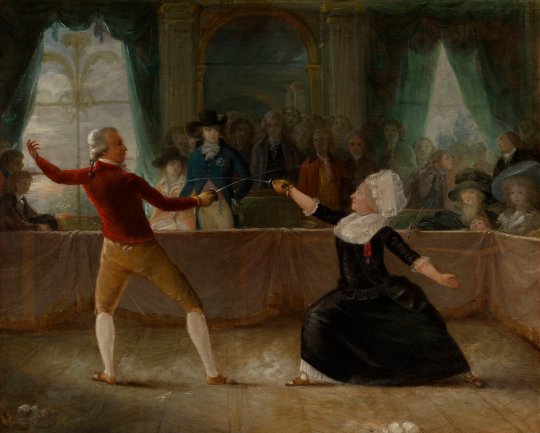
[The Fencing-Match between the Chevalier de Saint-George and the Chevalier d'Eon, c. 1787-9 by Alexandre-Auguste Robineau, via the Royal Collection Trust.]
If you're going to do this one I'd consider using the Mather Brown portrait of Saint-Georges as a reference. Saint-Georges himself said "c'est si resemblant c'est affreux" [it's so lifelike it's frightful]. (The Chevalier de Saint-Georges by Gabriel Banat p342)

[Monsieur de St. George, c. 1788, print by William Ward after Mather Brown, via The British Museum.]
A Different Fencing Match
To mix it up you could depict her fencing Mrs. Bateman whom d'Eon had a professional partnership with. D’Eon complimented Bateman’s fencing skills describing her as “a youngling in her nest, that would rise and support the honour of female heroism in England.” (Diary or Woodfall's Register, 18 Jan 1793)
On Thursday the 30th of May 1793 Mrs. Bateman held a benefit night at the King’s Theatre in Haymarket. There was a performance of All in the Wrong, Mrs. Bateman played Lady Restless. The Morning Chronicle reports “After the play, the Chevalier D’Eon in generosity of friendship, displayed her wonderful talent in fencing. She first pushed carte and tierce with her youthful imitator, Mrs. Bateman.” (31 May 1793)
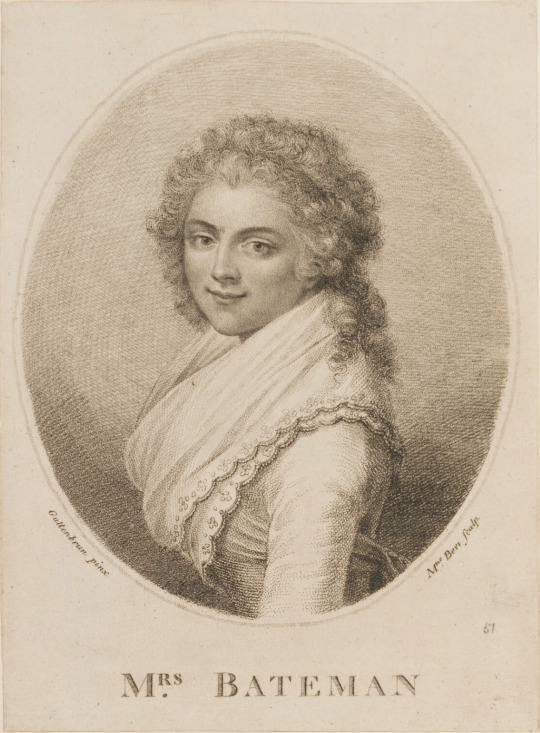
[Mrs Bateman, print c.1793 by Marino or Mariano Bovi (Bova), after Ludwig Guttenbrun, via the National Portrait Gallery]
You could also depict her fencing a gentleman in her stays and petticoats. D'Eon finding woman's clothes restrictive when fencing started to strip down to allow for more mobility. This incident caused a bit of a commotion in the English press.
After her fencing display with Mrs. Bateman at the King’s Theatre in Haymarket d'Eon fenced with a gentleman, in preparation she “pulled off her jacket, and thus stripped to her stays, with her handkerchief loose over them, and short petticoats that did not come half way down her legs”. (The Times, 31 May 1793)
The Sun was scandalised writing that “the indecent circumstance of her stripping herself to her stays, preparatory to her fencing, gave a very general disgust.” And while The Times conceded credit to “the Lady’s science and activity” they were horrified “to see an old masculine woman of sixty thus attired, and publicly exposing herself on the stage,” declaring that it was “an indecency which we shall never suffer to pass by without a very severe animadversion.” (The Sun, 31 May 1793; The Times, 31 May 1793)
Her Presentation at Versailles
After d'Eon returned to France in 1777 she was presented to the King and Queen at Versailles. While she had already been telling people she was a woman before this point and was already legally acknowledged to be a woman this was important because it was the first time she was being publicly acknowledged by Louis XVI and Marie Antoinette as a woman in a formal context.
On the 23rd of November 1777 Mémoires secrets pour servir à l'histoire de la République des Lettres en France reported:
Il doit y avoir aujourd'hui un concours de monde prodigieux à Versailles. Ensin la présentation du Chevalier d'Eon represent son sexe véritable, qui est celui de femme, annoncée depuis longtems, va s'effectuer dans son nouveau costume. Mlle. d'Eon continuera à porter la croix de St. Louis attachée à son côté
[Today there must be a prodigious concourse of people at Versailles. Thus the presentation of the Chevalier d'Eon represents his real sex, which is that of woman, announced for a long time, will take place in his new costume. Mlle d'Eon will continue to wear the cross of St. Louis attached to her side]*
In the weeks leading up to the event d'Eon was prepared by Marie Antoinette's marchande de modes Mademoiselle Bertin. Bertin worked not only on d'Eon's dress but to teach her how to move in it. At the French court women were required to wear the grand habit de cour which was a lot for d'Eon to get used to:
La plus grande peine de M.ˡˡᵉ Bertin fut de me faire attraper la marche. la demarche, & la contremarche d'une femme à la Cour, de me faire avancer & reculer noblement en robe longue & deplyèe sur un vaste panier qui à lui seul remplissoit la monitié de ma chambre. Mais l'aimable & doucereuse Bertin aprés s'etre insinueé fort avant dans mon amitié, me fit avancer & réculer comme elle voulut, elle me fit faire toute ce quelle jugea convenable aux habitudes, aux usages & à la décence qu'on demandoit en moi.
[The greatest difficulty for Mademoiselle Bertin was to make me learn the march, dismarch, & countermarch of a woman of the Court, to make me move forward & backward nobly in a long gown spread over an enormous hoop which on its own filled half of my chamber. But the kind & sweet Bertin after being strongly insinuated in my friendship before, made me more forward & back as she willed, she made me do all that she thought proper to the habits customs & decency that was required of me.]**
D'Eon complained that the first time Mademoiselle Bertin dressed her it took four hours and and ten minutes:
Je vous dirai que ma premiere toilette entre les mains de la chaste Bertin & de ses modestes Aides-de Camp, fut accomplie en moins de quatre heures dix minutes! juger de mon tourment & de ma patience!
[I will tell you that my first toilette at the hands of the chaste Bertin & her modest Aides-de-Camp, was completed in less than four hours ten minutes! Judge my torment & my patience!]**
In repose to d'Eon's complaining Mademoiselle Bertin told her:
Mon brave capitaine ne jurez pas. Le jour que vous serez presentée au Roi & à la Renie, vous serez bien heureuse, si je ne vous fais pas lever à quatre heures du matin, pour être prête à une heure aprés midi
[My brave captain do not curse. The day that you will be presented to the King & to the Queen, you will be very happy, if I do not make you rise at four in the morning to be ready at one in the afternoon]**
Of course we know d'Eon was wearing her cross of St. Louis but we unfortunately don't have a detailed description of her presentation gown. In her autobiographical writings d'Eon says it was made of embroidered white satin. Kimberly Chrisman-Campbell in her article Dressing d'Eon comments that this seems odd as "etiquette stipulated that only debutantes in mourning could wear white, rather than black, which was reserved for presentation at court, mourning, and some religious habits in the eighteenth century." She suggested d'Eon may be "literally whitewashing" history but concedes that it is possible that her "presentation coincided with one of the frequent and somewhat arbitrary periods of court mourning." (p104)
During the time d'Eon spent at Versailles she had to wear both formal and informal dress as dictated by the Court calendar. She commented that "Le deshabillé me convient fort, mais quand il ma faut porter le grand habbillement [sic] avec ajustement & parure c'est pour moi un grand tourment" [The informal dress suited me very well, but when I had to wear the formal dress with accessories and jewels, it was a great torment for me]**.
*this was translated by google translate. If anyone wants to add a better translation I'd love that.
**All of these quotes are from d'Eon's autobiographical writings which are all quoted and translated in Dressing d'Eon by Kimberly Chrisman-Campbell.
46 notes
·
View notes
Note
What did the Hamiltons usually do in the summers? Did they take vacations? EH used to travel to Albany with the children but after 1792 she did not leave AH alone again. Did she continue traveling to Albany but taking AH with her, or did they have other plans for the summer?
way too long DNR summary: they didn't really take vacations in the summer, or at other times of the year. At no time did Eliza, in particular, go and visit her parents on some regular schedule.
I think AH spent more time with his wife's parents in Albany during their married life than she did! AH is more frequently going up there because he has to be at court (NY Supreme Court in session in Jan, Apr, July, and Oct, and Court of Errors in session right after, as far as I can recall) or a matter he's dealing with is in arbitration, or some such - she often doesn't go with him, though.
I think Eliza was a lot more independent and assertive and knew how she wanted things than is acknowledged - I don't think these were traits that suddenly appeared after AH died. She grew up without her father around for chunks of time (why don't we ever discuss that bit of bonding about somewhat absent fathers that she and AH could have had), and then in the chaos of the AmRev, while still a teenager, she's trusted at times to run the households while her father is away general-ing and/or having to do political stuff elsewhere, and her mother is managing their other properties -her parents were likely in Saratoga and she was managing things at the Pastures right before she got married in late fall 1780. Once she finally got to establish her own household, I don't think she loved going back to stay with them and having to fall in line with how her parents wanted the household to work - that's entirely my speculation though. Maybe she secretly hated them, maybe she had some trauma/stress around being in Albany and Saratoga from her childhood, when that was considered the frontier, or from her war experiences, maybe she just didn't want to have to manage the packing and moving of servants that was also necessary or have the funds to make it sensible, maybe the arrangements she had with her servants made it difficult to agree to travel (there was a shortage of "good labor" in the cities), maybe she enjoyed her thriving social life elsewhere and hated being back in Albany and hearing "the Dutch bell," as Angelica C. jokes about.
To the actual question! If you want a detailed report, @runawayforthesummer is probably the best person to ask, as she developed a timeline of the locations of all the various family members based not only on publicly available documents but on Schuyler family letters and other documents that required on the ground research. Below is just my rough summary of what I can remember - parts may be wrong, but I think it's generally okay.
Summer of 1781: he goes off with the military, ultimately to VA
Summer of 1782: still on her parents' property in Albany with baby Philip
Summer of 1783: the same, though he's traveling a bit more.
Summer of 1784: living in NYC, she stays there while he briefly travels (she gives birth to Angelica H. in September)
Summers of 1785-88: mostly in NYC (with two more bio kids added to the family, and Fanny added in 1787), although now we know she went to Philadelphia in June 1787 around the time AH gave a speech at the Constitutional Convention. (It had been assumed she spent the summer in NYC, as AH was known to be back there briefly in July, and James A. H. was born in April 1788, so easy to deduce that she must have been in NYC, too.)
Point to note here and for the next 15 years or so: just because the Hamiltons weren't traveling back and forth to Albany doesn't mean that family members from upstate NY were stuck in place. Peggy and hubby Stephen van Rensselaer stay with them, Eliza's brother is sent to live with them by Philip S because he thinks their good example will rub off on his wayward son, Eliza's youngest sisters Cornelia and Kitty/Caty (little Catharine b 1781) also live with them at various times, and Philip S. and Catharine are fairly frequently visiting when Phil S. isn't too sick to travel (and since Philip S spends two years as a U.S. Sen, they're also sometimes living in the same city as the Hamiltons anyway).
Summer of 1789: this is an interesting year, because Angelica Church returns back to NY for the first time in nearly six years; she just barely misses the inauguration in April. And then Angelica actually spends most of her time in upstate NY - contra one particular Hamilton biographer who alleges (based on nothing) that Eliza spent most of her time that year in Albany while AH and Angelica were having a torrid affair in NYC. The interesting part? If Eliza went up to Albany at all while Angelica was there, she didn't spend tons of time there. Phiiip S. requests in May that everyone goes up as he wants his whole family together- someone else probably knows whether they actually did. Eliza and the kids also may have gone to Albany in Nov 1789 after Angelica has leftl; AH is too busy with work to go.
Summer of 1790: she and the kids go to Albany. But she just goes up in September and is likely back within three weeks - the plan was that AH was also going to join them, but then he's too busy with work.
Summer of 1791: back in Albany for Eliza and the kids, this time to get away from hot Philadelphia, but actually only gone the last week of July to beginning of September, and he makes a brief trip to NJ during that time, too. But she and AH also took a trip "to the country" together for two weeks in May, sans kids - he doesn't even send any letters during that time.
December of 1791: Philip H. starts boarding school - I point this out not only because both his parents escorted him to boarding school (taking a mini-trip themselves), but because the patterns of the older boys' schooling - usually in school at least through July - from here on out would have prevented summer trekking to Albany, anyway.
Summer of 1792: the Hamiltons remain in Philadelphia, where Eliza gives birth to John Church H in August.
Summer of 1793: YELLOW FEVER REACHES PHILADELPHIA! They stay in Philadelphia but rent a house outside the city. The children are eventually sent up to Albany, and Eliza and AH end up there, too, for a couple of months after Edward Stevens nurses them back for health. EH and AH return to Philadelphia together, and then AH probably had to send a threatening letter to his father-in-law to return his kids. (Philip S. had written that AH was clearly still too sick to have proper judgment on whether the kids could return.)
Point to note here: just because AH and EH are in their usual residential spot doesn't mean that all of their kids are there with them. At various times over the years, and in varying combinations, the kids get brought up by a relative or left by their parents in Albany - Eliza's married siblings are in upstate NY so they have first cousins and a ton of other relatives; their grandparents or Aunt Peggy take over their tutoring and other instruction, etc. They get returned when another relative is traveling back to Philly/NYC.
Summer of 1794: it doesn't seem like anyone planned to go to Albany, but JCH gets sick and Eliza is pregnant, and they try a brief excursion away from hot Philly but JCH doesn't get better, so in late July, AH escorts both of them (likely with James A. H.) up to Albany and then rushes back down and Angelica H stays with him, while Phil and Alex eventually go back to school in Trenton. And then they have an awful couple of months, because although JCH recovers, AH leaves to deal with the "insurrection" in October and pretty much all the Hamilton kids get sick while he's away. Eliza has to go get the oldest boys from school. AH, who was always recommending medical treatments and played a big part in nursing the family when anyone got sick isn't around (the old thing of him intending to become a medical doctor when he left St. Croix). It largely all falls to Eliza and her parents and maybe a few siblings come down to help her out, and then she gets sick too (or is just so exhausted) - Edward Stevens helps take care of her - and she loses the baby. AH gets home and sends his resignation letter to GW and accepts the guilt of being the reason Eliza was ill.
Late winter/early spring 1795: the above led to the longest "vacation" they probably every took - after his resignation is official on Jan 31, the Hamiltons leave Philly on Feb 17 and travel to upstate NY via NYC, arriving in March, and stay there all the way until June. They make some mini excursions, but it looks like a deliberate downtime after an exhausting 6 years and super rough eight months. It also gives AH time to evaluate how poor (relative to others in their social class) they are due to his time in the admin. And then they settle into life back in NYC and AH's return to his law practice (and interference in any number of other political happenings).
Summer of 1795: YELLOW FEVER REACHES NYC! And they stay in the city, to Philip S's great panic for this and every subsequent NYC summer prior to the Grange. AH has Jay Treaty stuff, running the Washington admin from a distance, and establishing his law office to deal with. And they host Talleyrand. They also now have four (?) non-bio kids living with them.
Summer of 1796: Still in the city! The older boys are in school; AH goes up in October.
Summer of 1797: Yep, still there! The Churches return from Europe in May (and subsequently, Angelica C. spends way more time in Albany than it seems Eliza ever does). They have the whole Callendar/Reynolds/Monroe debacle to spice things up; Eliza gives birth to William in August. Most interesting - Philip S. was very ill in April 1797 - they thought he was going to die. Eliza doesn't go to Albany to visit him immediately, even though AH is there! At least Cornelia is with her, so they were bad daughters together; they may have gone briefly after he recovered. AH is absent again when Phil H. gets extremely sick in the fall.
Summer of 1798: Ah, Eliza finally goes back to Albany again without AH! And she's super unhappy about it or she and AH had some big fight before she left, based on AH's and Angelica C's letters to her. She takes baby William with her - Angelica H. might already be up there - but the older boys stay in the city with AH, and Angelica C., Peggy, AND Cornelia are in the city keeping an eye on him anyway (and likely helping with the kids). Eliza doesn't even stay three weeks before going back home (even though it seems AH thought she might stay away longer, maybe in retaliation or something). They rent a house outside the city with the Churches to get away from the yellow fever outbreak.
1798 is also the year when AH starts to complain A LOT in his letters about having to travel and any separations - he always expressed sadness about it and his anxiety increased the longer they were apart, but in this year and onwards it really carries a "this sucks and I hate it and I cannot do it much longer, I need the comfort of my family all the time" tone - even Angelica C. notes his unhappiness about separations and that anything that seems to affect Eliza or the children in his absence really drags him down.
Summer of 1799: still in NYC! Eliza's also pregnant and gives birth to a real Eliza in Nov.
And nothing much changed for the remaining summers, except adding the Grange as a place they could go, which was entirely the point . AH is in Albany for business/court and stays longer to be there when Peggy dies in 1801; Eliza does not go up. Philip H's death in Nov 1801 leads to an invitation from Phil S that they come to visit, which it seems that they do in January 1802 and then return to NY - Eliza is pregnant and there are frequent concerns that she's going to lose that baby (whether because she's actually ill or so grief-stricken) and AH does not respond to condolences until March, but Lil Phil is born healthy in June 1802. Eliza goes up solo after her mother dies in spring 1803 to comfort her father but doesn't spend much time there. The Hamiltons go into a pattern, esp in the warmer months, of Eliza staying up at the Grange with Angelica H. and the youngest children and AH staying in the city with the oldest boys during the week and coming up to the Grange on the weekends, a separation that Eliza would describe as a "sacrifice" they made so that their kids would always have a parent with them. (Beyond first Philip H's death, there were concerns that NYC was becoming increasingly dangerous.)
Apologies for errors - I am largely working on memory and have not confirmed all details above, but there are better sources for that.
8 notes
·
View notes
Text

Public. "In another sense the word does not mean all the people, nor most of the people, nor very
many of the people of a place but so many of them as distinguishes them from the few". Black’s
Law Dictionary, 4-6 Ed.
As a result of the substitution fraud engendered by the "election" of Abraham Lincoln as the "President" of the British Territorial Corporation doing business as "the United States of America, Incorporated" in 1860, and his subsequent usurpation of powers belonging to the Federation of States and The President of The United States of America under False Pretenses, there has been a continuing confusion about "Which Public?" is to be served by the Federal Government Subcontractors --- their own "public" consisting of their own incorporated "citizenry", or our General Public of the American States?
The quick answer is that their organizations exist because of their respective Constitutions, but they are not parties to nor beneficiaries of the Constitutions. They are paid employees charged with duties and limitations provided by the Constitutions. Federal Employees denoted as Federal Citizens, or specifically as U.S. Citizens or citizens of the United States, work under the provisions of their respective Constitutions, but have no Guarantees provided by the Constitutions, for they are not Parties to the Constitutions nor Creators of the Constitutions.
This has always been the case, ever since the implementation of the Constitutions in 1787, 1789, and 1790, respectively.
In respect to the American Federal Subcontractor, the States of America functioning under The Constitution for the united States of America, provisions were made to enable Americans born in the States of the Union (the original Union, not anything to do with the Civil War) to retain their Constitutional Guarantees as American State Citizens on a private basis while rendering international public service as employees of the original Federal Republic government.
This arrangement was known as "Federal Dual Citizenship" and was set up by the first Naturalization and Immigration Act --- this phrase "Federal Dual Citizenship" has since been redefined and subverted to mean that present day Federal Subcontractor Employees from anywhere on Earth are "presumed to be" both Territorial U.S. Citizens and Municipal citizens of the United States, but this is not the customary and intended meaning of the Public Law still standing among the United States Statutes at Large, Unrevised.
The British Territorial Government made no such provisions, because their U.S. Citizens already owe allegiance to the British Monarch and have adopted British Territorial/Commonwealth political status the same as the people of Puerto Rico, which is a British Commonwealth nation.
The Municipal Government run by the Holy Roman Empire similarly never referenced Americans; their citizens of the United States were understood to have their Federal Dual citizenship allocated already by their allegiance to the Pope/Roman Pontiff.
Thus, among the original Federal Subcontractors, you had three different possible kinds of "Federal Dual Citizens":
United States Citizens - American State Citizens
U.S. Citizens - British Territorials citizens of the United States -- Holy Roman Empire citizens.
This results in three distinct populations with unique political identities and "public" bodies associated with each.
None of these "publics" are the Public to be served under the provisions of any Federal Constitution, though enterprising public servants have usurped against the Employers and sought to substitute their "publics" for the American Public.
When the American Federal Subcontractor ceased to function in April 1861, the other two foreign Federal Subcontractors rushed in to fill the gap and to provide the services and exercise the authority and delegated powers of the American Federal Republic in its "absence".
This has been their story and excuse ever since. They, both Britain and Rome, have told the world that the American Government is unaccountably "absent", "missing, presumed dead", and "in interregnum".
All that is or ever has been "missing" is a Subcontractor of our government, not our actual government which delegated all the federal powers in the first place.
The two remaining foreign Federal Subcontractors freely misrepresented themselves as our custodians and representatives, usurped the powers delegated to the American Federal Republic, and exercised those delegated powers without a contract to do so.
From the perspective of the trusting American Employers, all appeared to be well. The duties of the Federal Republic were being accomplished and the exact details of how this was being done -- via the two other Federal Subcontractors -- was conveniently not revealed.
Thus the actual American Government was left in the dark and gradually fell into a comfortable stupor, while the remaining Federal Subcontractors were reorganized as commercial and municipal corporations, created "state of state" franchises for themselves and grew more and more corrupt.
We began waking up in the 1960's - 1970's when a series of events began ringing alarm bells. United States District Courts apart from the district courts of the United States (Article 5) appeared, but no effort was made to distinguish between these foreign Territorial and Legislative courts serving the Federal citizenries, and Article 3 Federal Courts and the actual State and County Courts owed to Americans.
The Office of the Secretary of War was renamed the Secretary of Defense. The Vietnam "War" was admitted to be a "Conflict" --- not a war. Richard Nixon converted healthcare into a for-profit enterprise to please his cronies at Kaiser-Permanente. Both the Internal Revenue Service and the Municipal IRS began prosecuting Americans for not "voluntarily" filing Federal Income Tax returns -- despite the fact that these Americans had no Federal Income and no legal duty to report.
By 1980, Jimmy Carter had the brass cajones to take over and federalize public education in America, leaving no doubt that as far as he was concerned, the "public" to be served was the British Territorial U.S. Citizen version, and not the American Public.
Carter scrubbed all mention of American History from the libraries and "public" schools, leaving only United States History to be studied by the next three generations of school children. Local School Boards were reorganized as "School Districts", even though no Federal Constitution allows this and even though, like public health, no mention of education exists in any Federal Constitution.
There seemed to be a concerted, organized effort to confuse Americans with their Federal Employees --- but to what end? By 1998, as we approached yet another Municipal Corporation bankruptcy (2000-2001) we raised our hand and objected to this continuing malfeasance and misrepresentation and served notice on the United States Secretary of State and the Commissioner of Internal Revenue and numerous other officials, challenging their authority and jurisdiction, dereliction of duty, and non-performance.
Coming out of the 2000 bankruptcy in which the City of Washington, DC, was emptied for 120 days, more alarming rumors began circulating, to the effect that foreign banks, most notably, the World Bank, Global Federal Reserve, and International Monetary Fund were making claims on abandonment, seeking to act as creditors of the foreign Federal Corporations and trying to attach American land and physical assets as "abandoned collateral" belonging to "unknown persons".
That would be us, or to be exact, the purportedly "absent" American Government -- which was only an American Federal Subcontractor instead -- that disappeared in the wake of the Civil War.
Unfortunately for them, we are still here, and still guarding our own Autochthonous people and our own country.
Their initial scheme, to use False Claims on Abandonment to steal everything from everyone, has failed.
Their further scheme, to misrepresent themselves and substitute a British Territorial Federal Republic for our long-lost American Federal Republic, has also failed.
Most recently, they have hauled another fraud scheme out of the rag-bag of history, and they are attempting to pull the same public trust bait-and-switch fraud that was used by Oliver Cromwell during the English Civil War.
What remains is for these fraudsters to Cease and Desist and admit that they have no standing in these matters of American health, education, finances, and asset management, no authority, and no contract allowing them to interpose themselves as our custodians or representatives.
Mr. Lincoln, his Executive Orders, his Lieber Code --- all of it, was exercised in fraud and with malice aforethought, all resulting in criminal malfeasance, unlawful conversion of American assets, and a century and a half of unlawful and illegal mercenary warfare carried out under color of law.
We, the American People, and that means specifically, the American State Citizens and American State Nationals, are the Public to be served by the Federal Subcontractors; our erstwhile employees are not empowered to serve themselves at our expense.
Our Autochthonous American State Citizens are the Principals enabled to enforce the Federal Constitution Contracts, and we are enforcing them in all jurisdictions, with prejudice, against the other Principals and Treaty Partners, their employees, subcontractors, and agents, not limited to the Holy See, the Holy Roman Empire, the Inner City of London, the Belgian Government, the British Government of Westminster, the British Monarchy, His Imperial Majesty King Charles III, Pope Francis, the Patriarch of the West, and all their various corporations, including their incorporated banks.
#youtube#ados#blacklivesmatter#blackvotersmatters#donald trump#joe biden#naacp#blackmediamatters#blackvotersmatter#news
3 notes
·
View notes